Stitch up some snuggles with our ultimate guide to free crochet blanket patterns. Here, you'll find top throw blankets, speedy afghans, charming baby blankets, and detailed c2c graphgans.
You'll also learn how to choose the right pattern for your skill level, what supplies are needed, and how to use unique stitches to design your own blanket. Plus, I share my best blanket tips that all beginners should know.

This afghan guide contains affiliate links.
Crocheting a Blanket for Absolute Beginners
No matter your skill level, we've got a free afghan pattern for you!
If you are just learning how to crochet–like, as you read this–my best suggestion would be to skip all these patterns at first. Instead, choose a chunky yarn you like and pair it with the hook size on the label for your very first blanket project.
Read more about how to crochet a blanket in our detailed tutorial.
Start Simple
I recommend beginners start with a super bulky yarn like Lion Brand Wool-Ease Thick & Quick and a size N crochet hook. Make a small square or rectangular blanket in half double crochet or double crochet stitches.
The point here is not to create the best blanket of all time, but rather to practice your stitch tension on a low-stakes project. Once your stitches are fairly even, you can move right on to more advanced-beginner level skills and concepts like those used in the patterns below.
Afghan + Blanket Patterns for All Skill Levels
Alright, let's dive into our favorite free crochet blanket patterns. You'll find this collection of patterns organized by blanket or afghan type, but many of these patterns fit into more than one category. Enjoy!
Easy Patterns for Beginners
If you're fairly new to crochet, you might be wondering – can a beginner crochet a blanket? My answer is an enthusiastic yes! As a newbie, you can complete your first afghan project using simple stitches and easy-row repeats.
Here are three basic types of patterns for beginners to try out:
- baby blankets - they’re generally a smaller project
- granny square blankets - they can often be worked in smaller, portable pieces
- chunky blankets - they tend to be fast projects
The following blanket patterns for beginners make for relaxing projects for experienced crocheters as well.
See all our free beginner blankets →
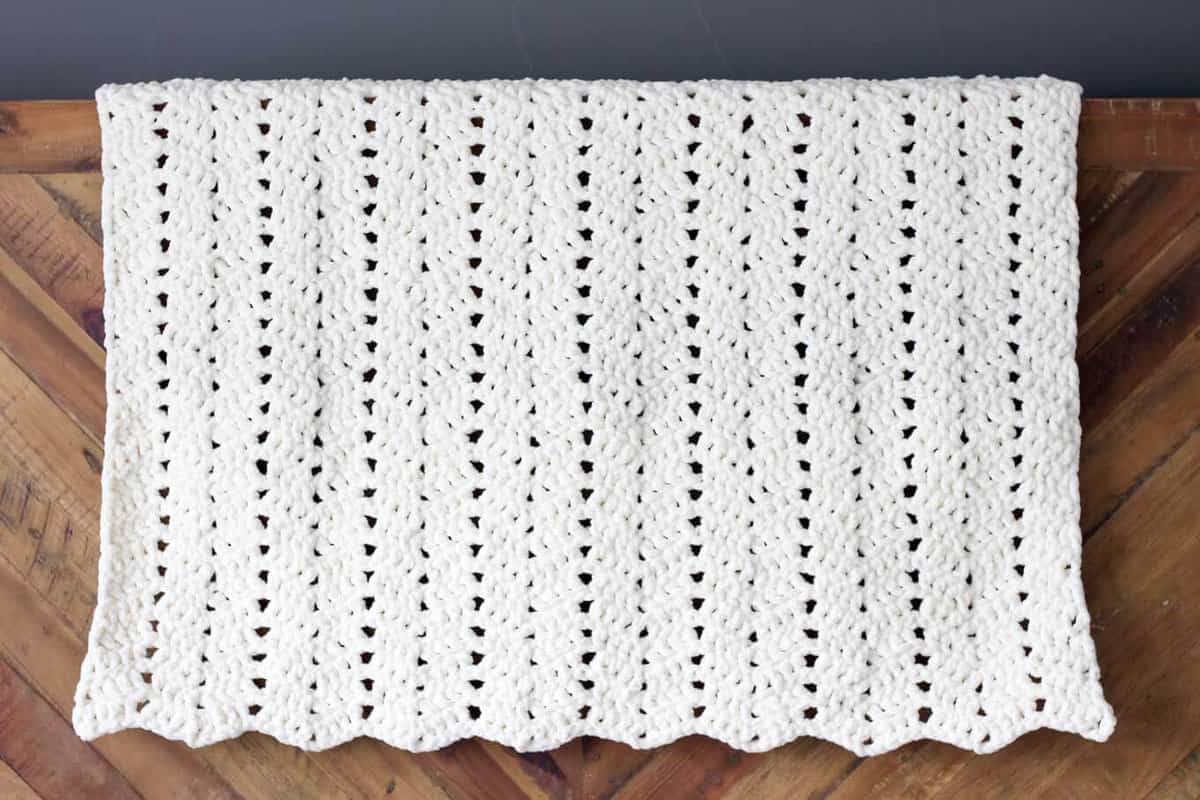
Free Modern + Chunky Blanket

Easy Double Crochet Afghan for Beginners
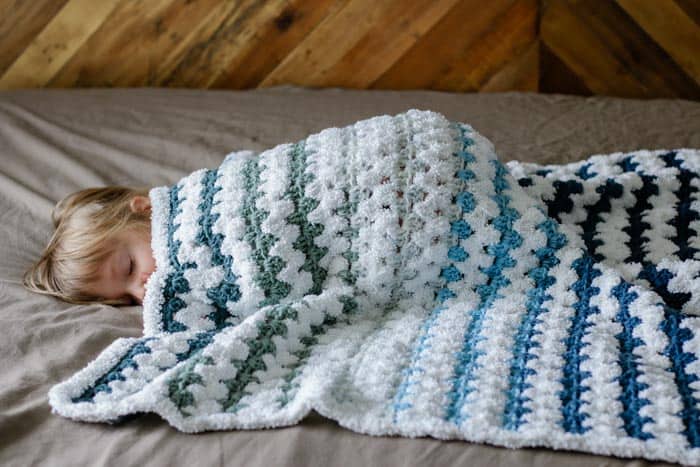
Tributary Beginner Baby Blanket
Unique Crochet Blankets
If you're looking for a beautiful design that offers a little something different, you'll love these free patterns. Each either uses creative construction or techniques to create a true show-stopper of a blanket.
See all our free unique crochet blankets →
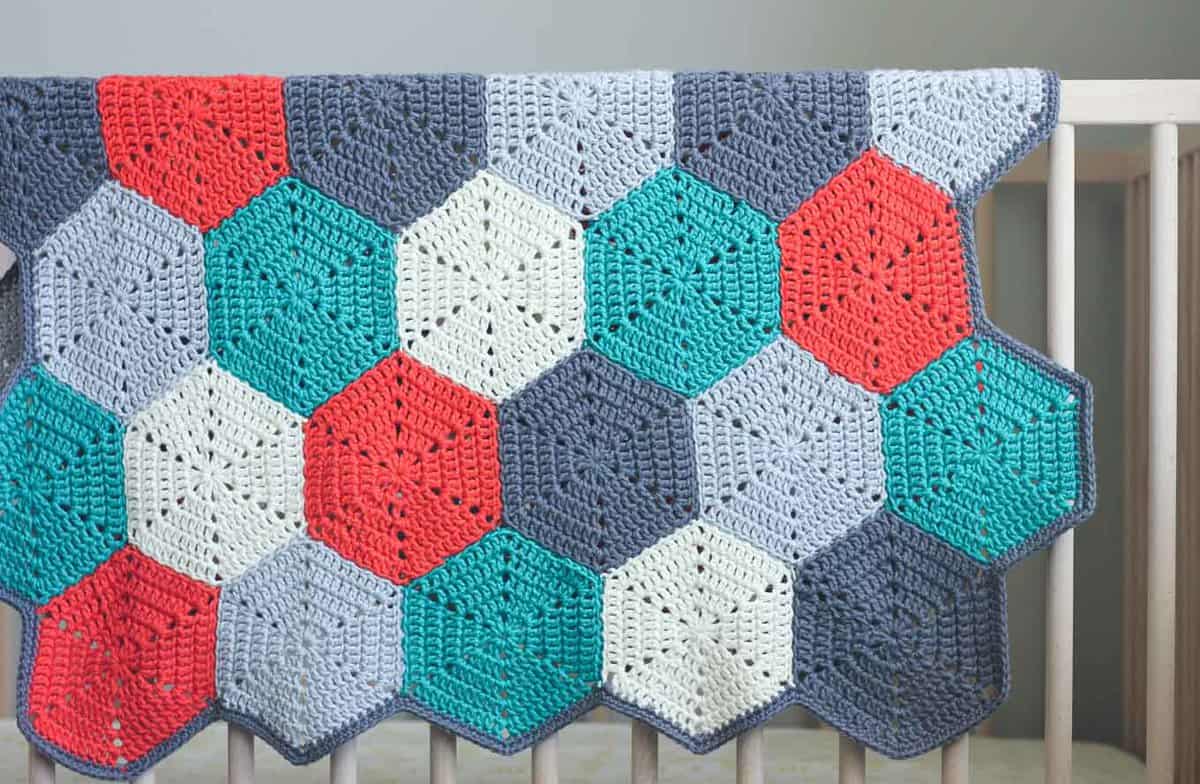
The Ultimate Hexagon Blanket
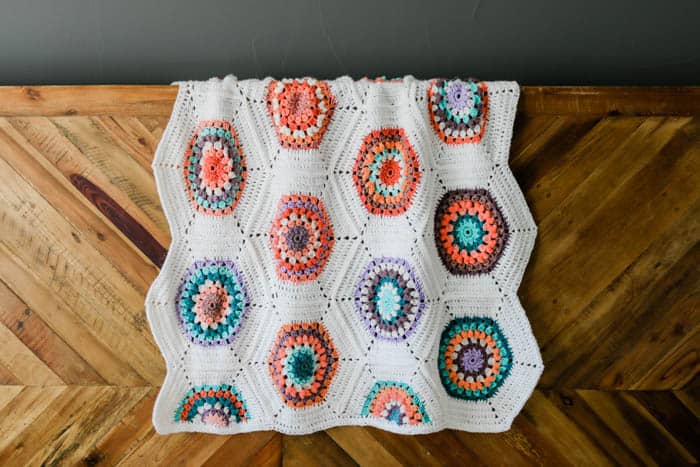
Flower Hexagon Quilt Pattern
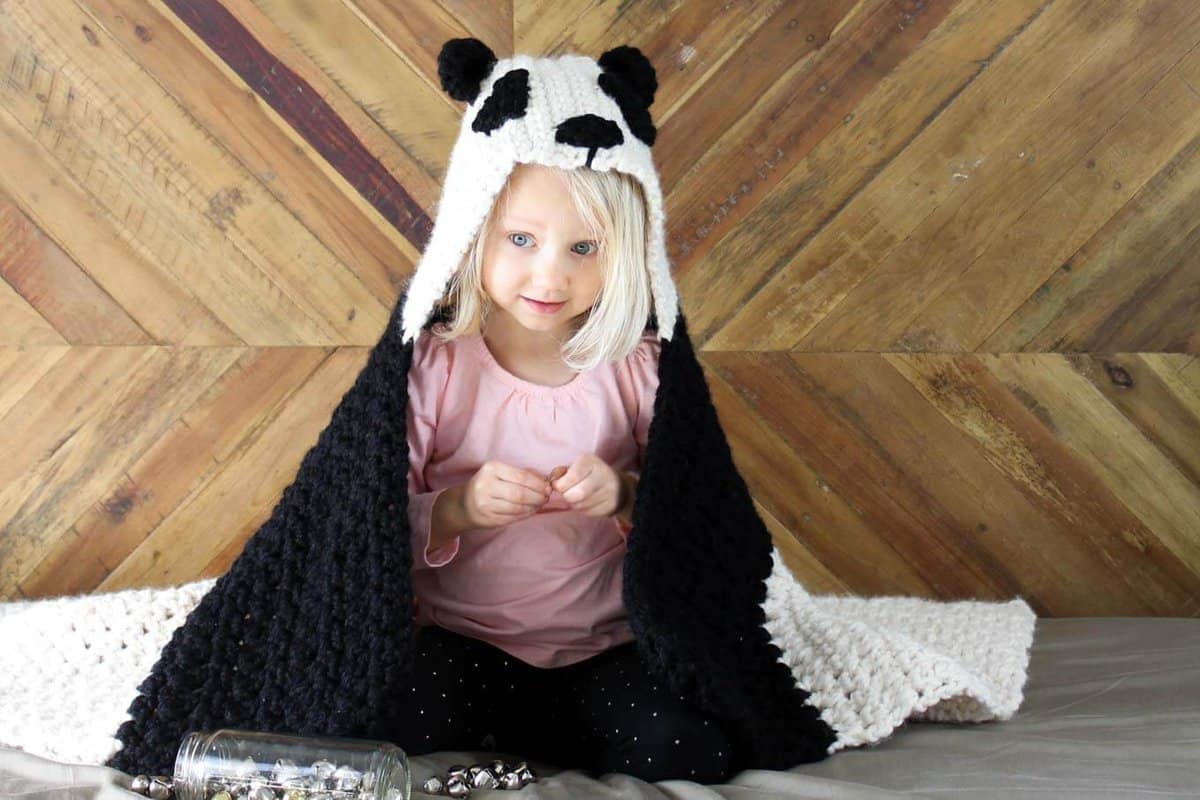
Panda Hooded Baby Blanket
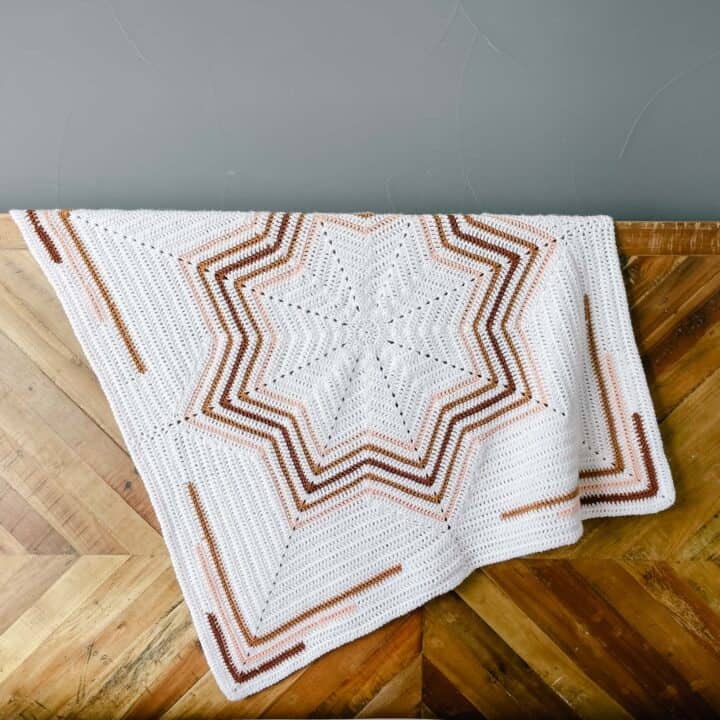
Modern 8 Point Star Blanket
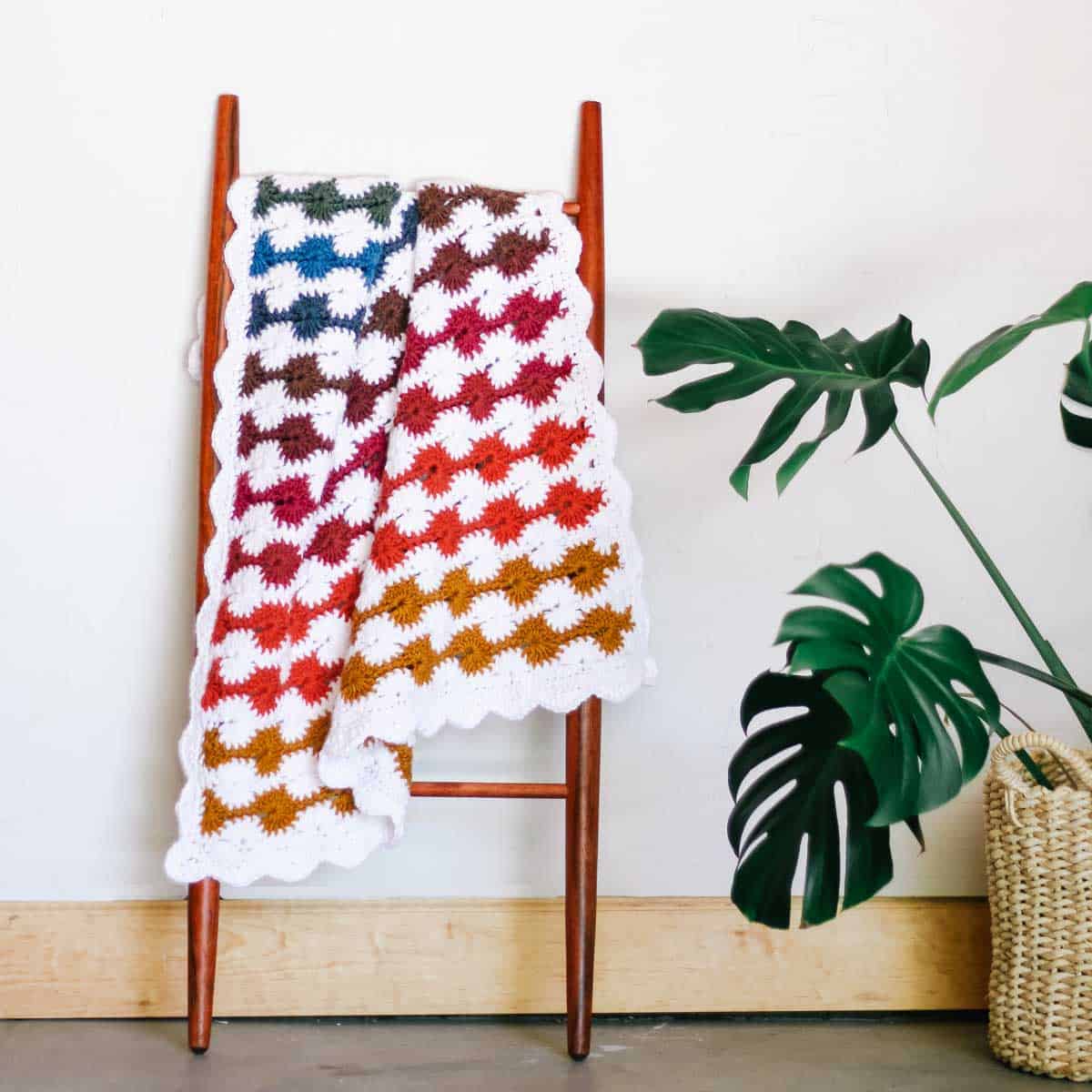
Easy Pinwheel Baby Blanket
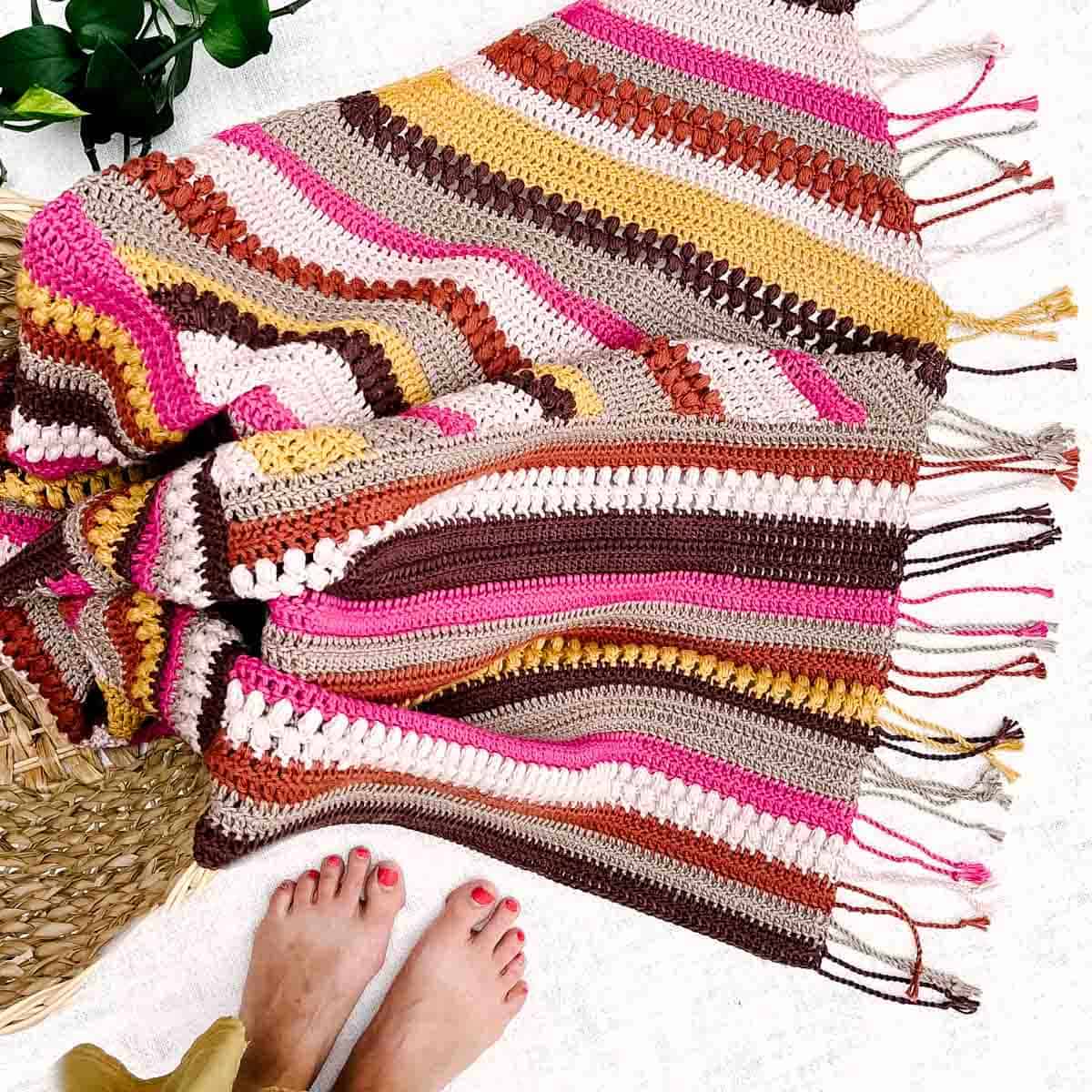
Crazy Quilt Patchwork Blanket with Twisted Fringe
C2C Crochet Blanket Patterns
Corner to corner (C2C) blanket patterns may seem difficult at first. But once you learn the basics of how to C2C crochet, you'll understand the endless possibilities of this technique.
Fair warning though, you may even find that you get so into C2C crochet that you want to learn how to design your own corner-to-corner graph patterns!
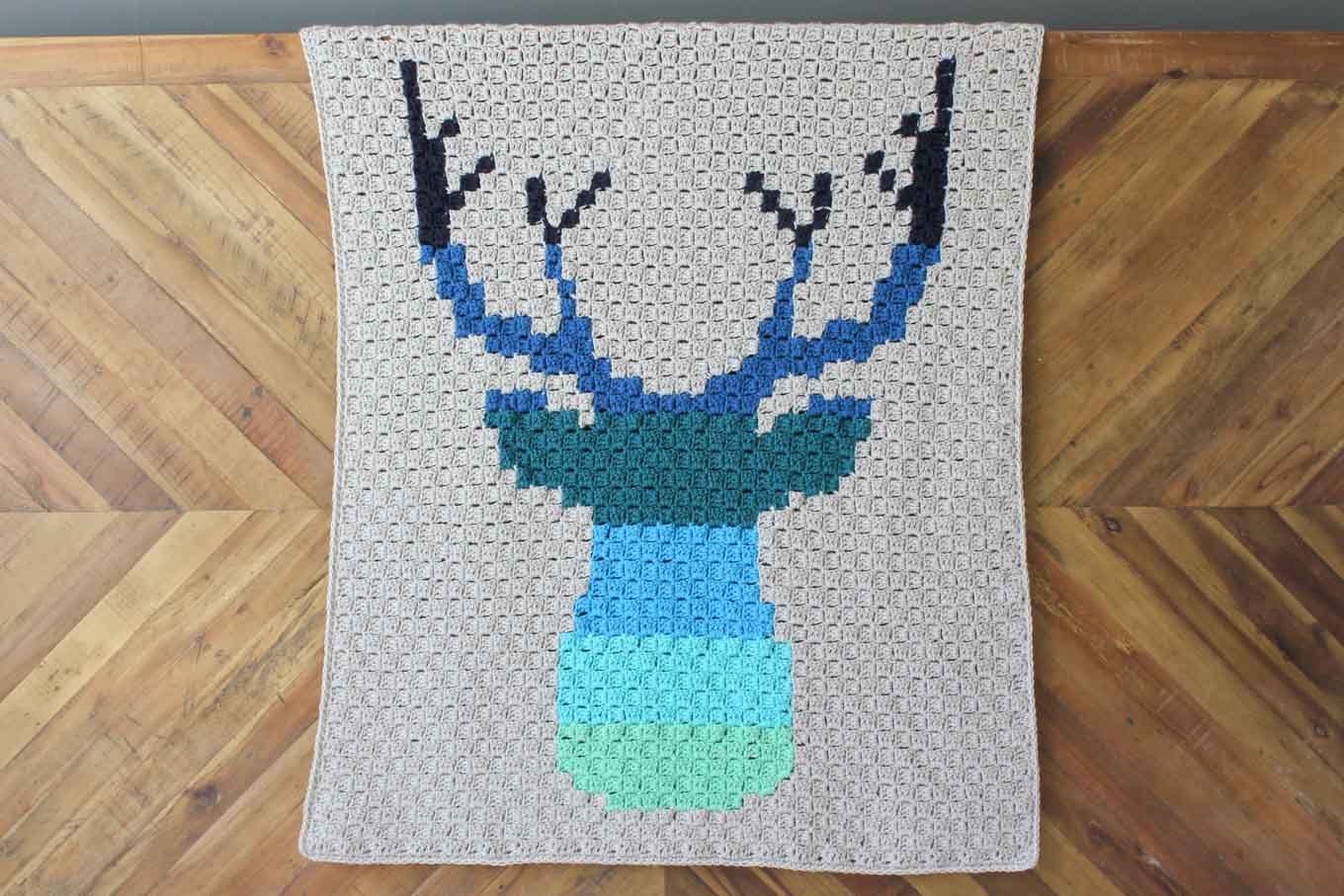
Modern C2C Crochet Deer Afghan
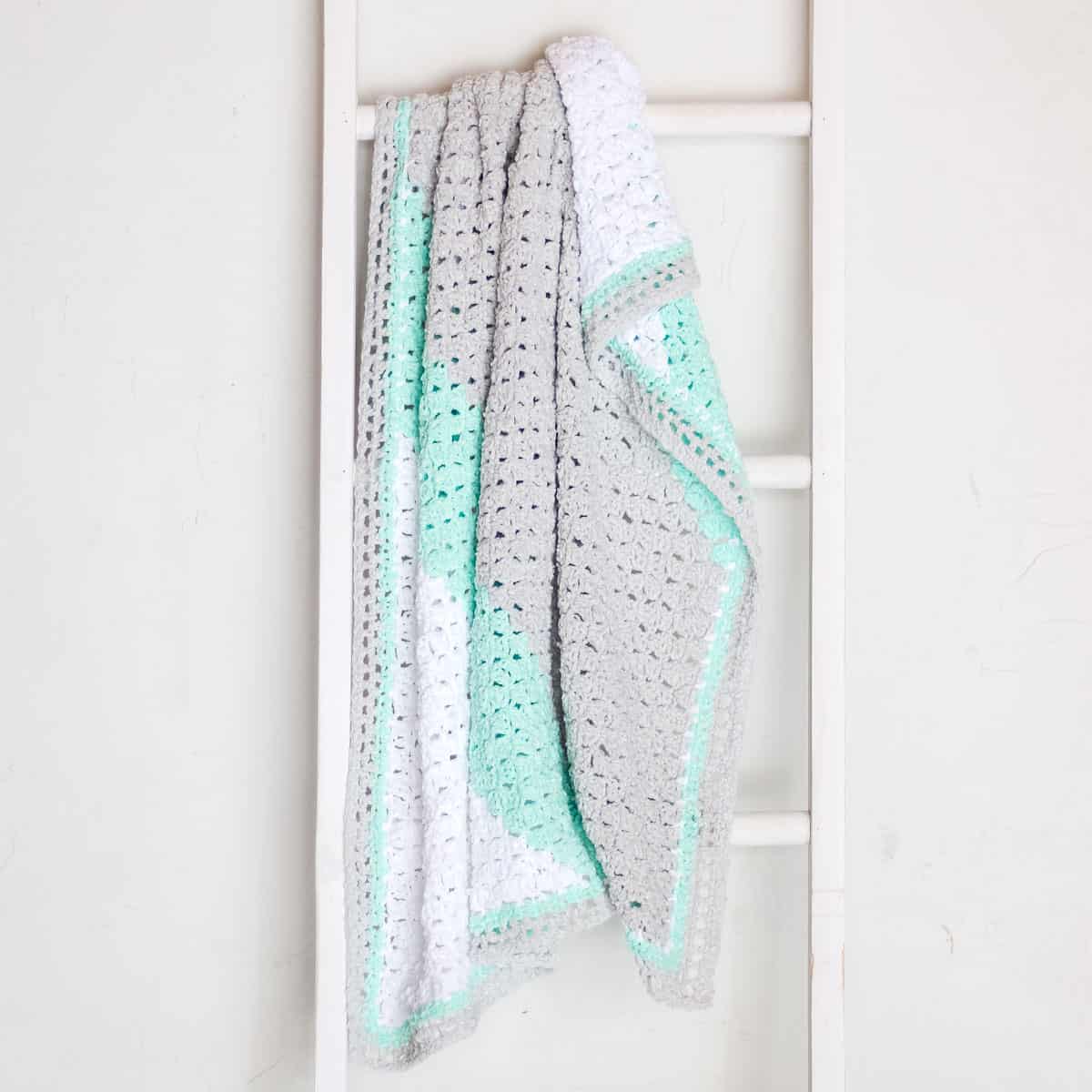
Gender-Neutral Striped Baby Blanket

Geometric Arrows Corner to Corner Throw

C2C Monstera Leaf Blanket
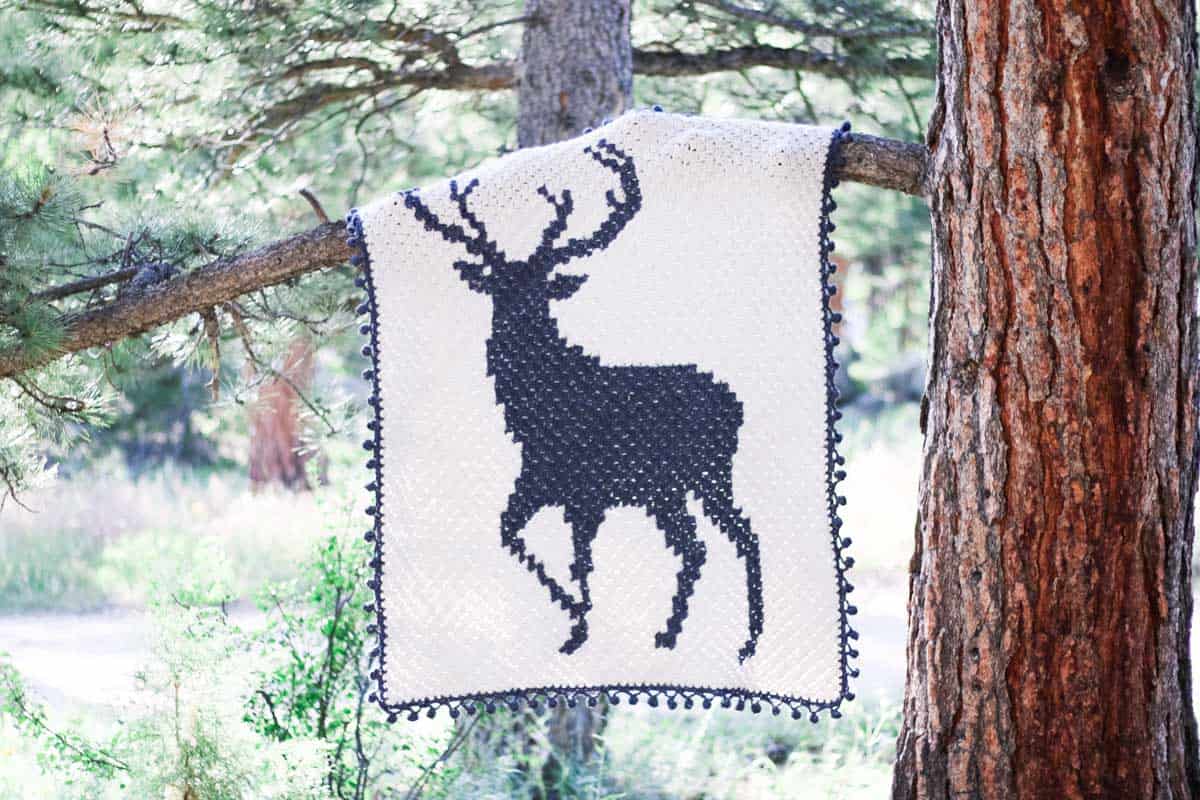
Modern, Rustic C2C Buck Blanket
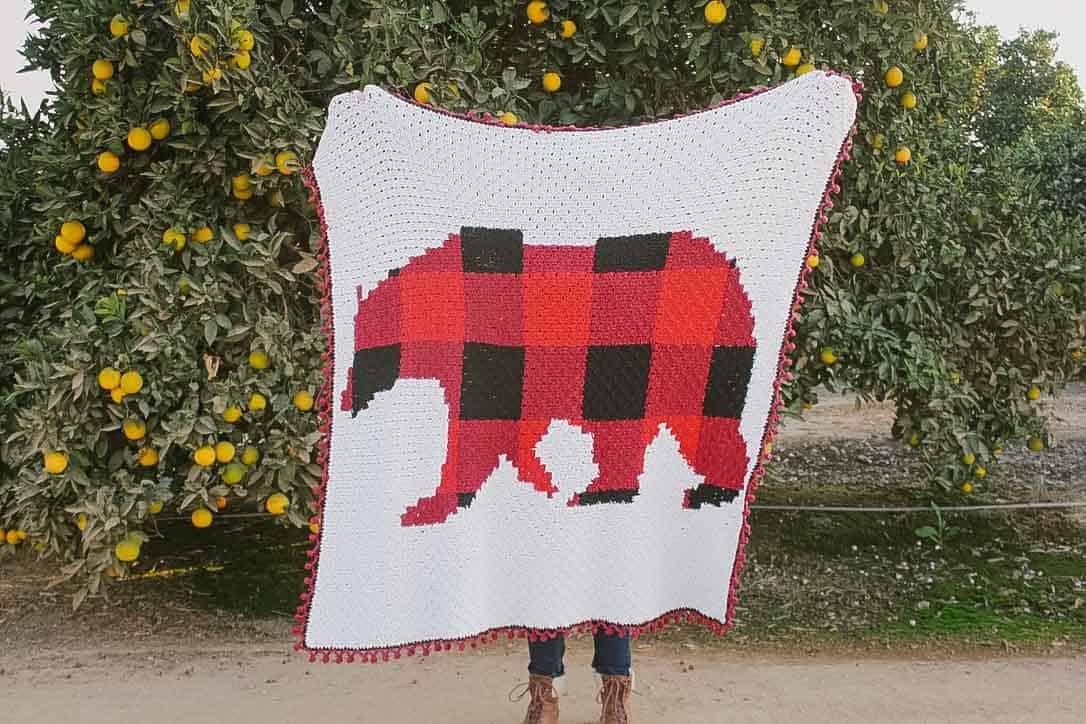
Plaid Bear Blanket
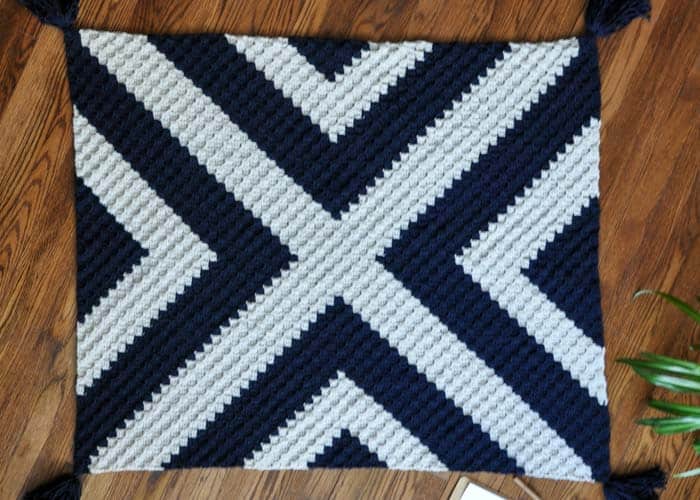
Modern C2C Lapghan Pattern
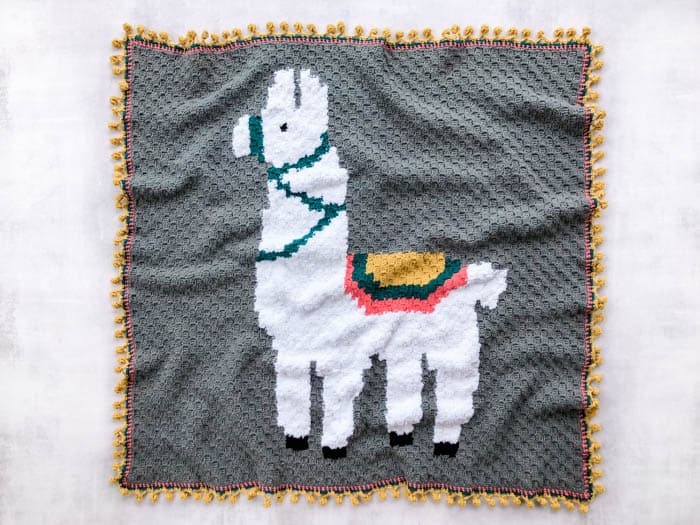
Alpaca C2C Crochet Blanket
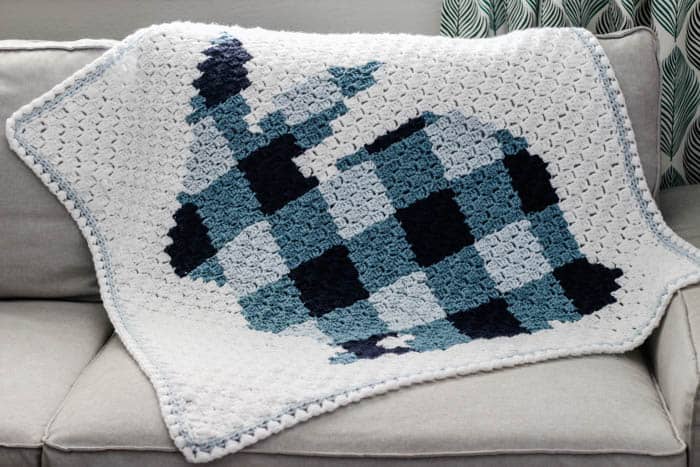
Plaid Rabbit Blanket
Related: Learn how to make the best yarn pom pom.

Africa Blanket Pattern
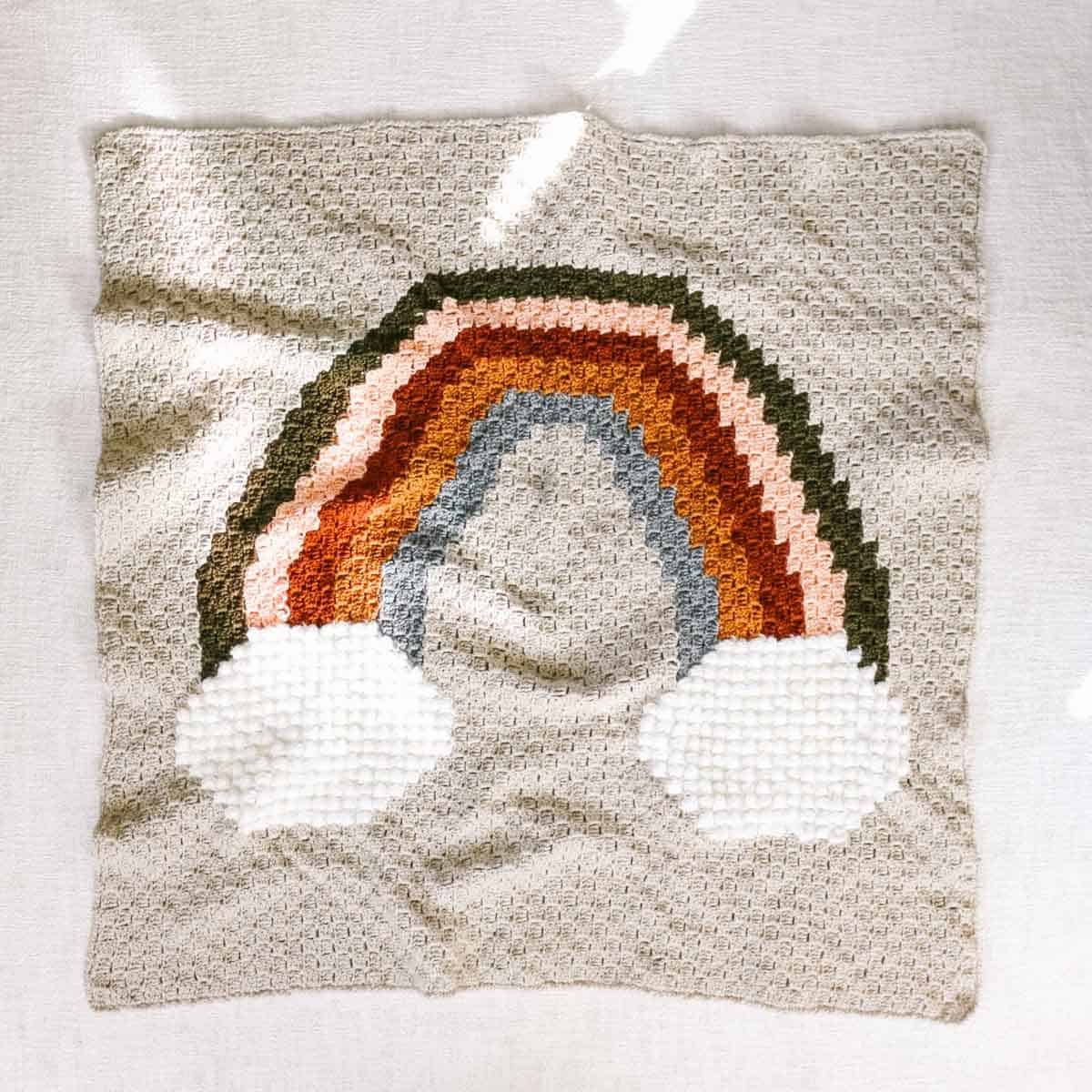
Modern Rainbow Afghan with Popcorn Stitches
Christmas Afghan Patterns
Many of us are willing to invest extra time and energy into Christmas crochet patterns because we know they'll bring joy for seasons to come. The following Christmas blankets are perfect for making your next heirloom.
My family looks forward to pulling out each of these holiday blankets every December!
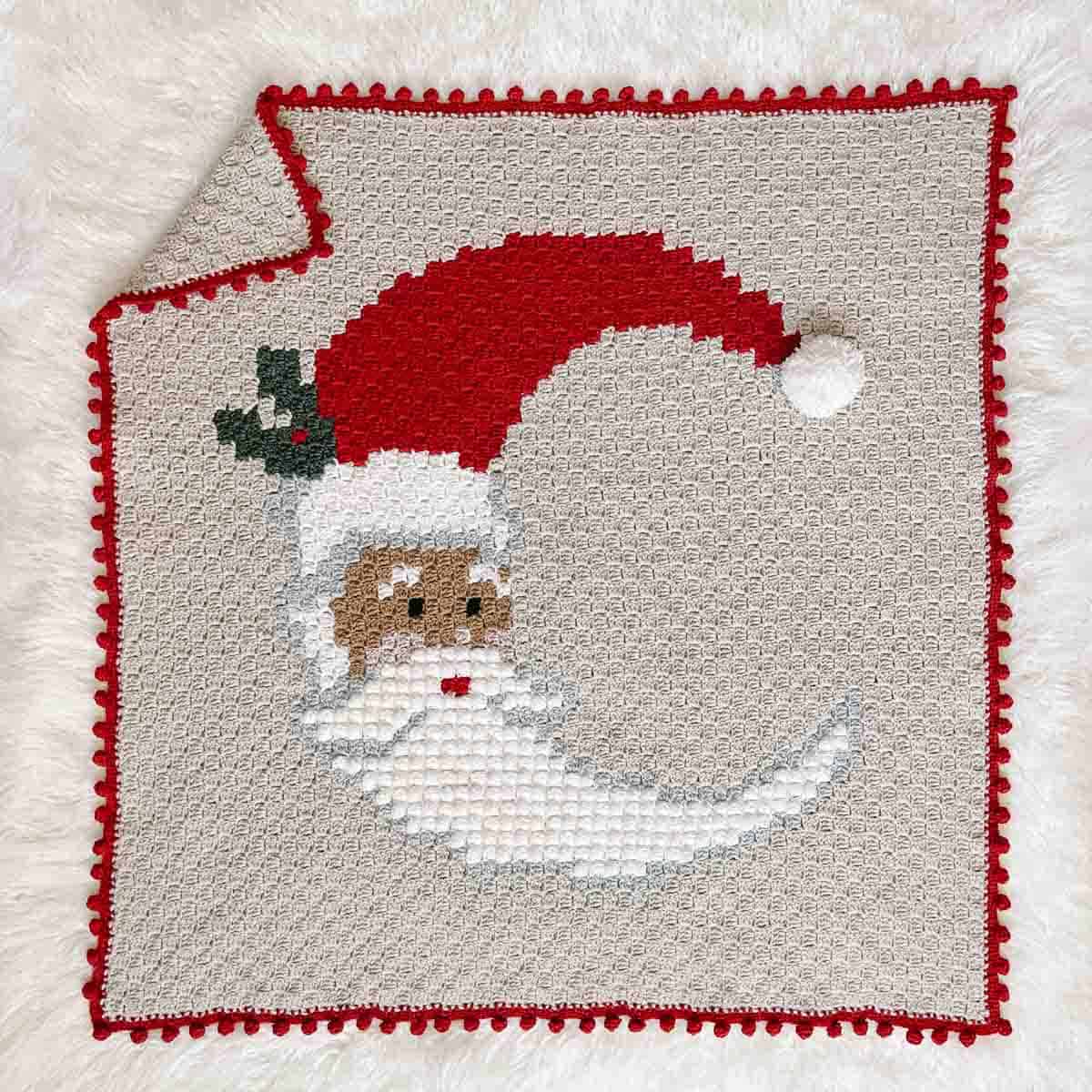
Holly Jolly Santa Blanket
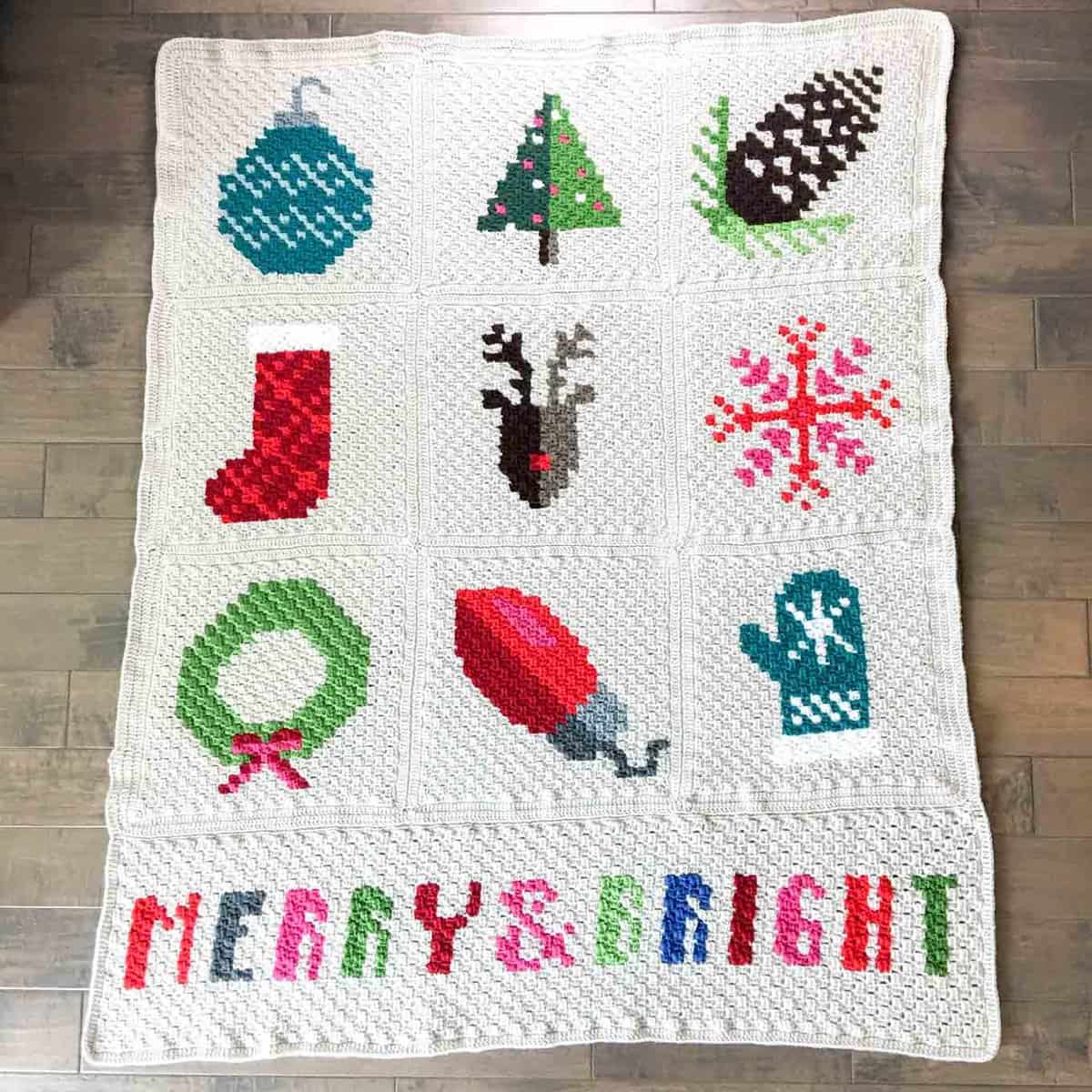
Modern C2C Crochet Christmas Afghan
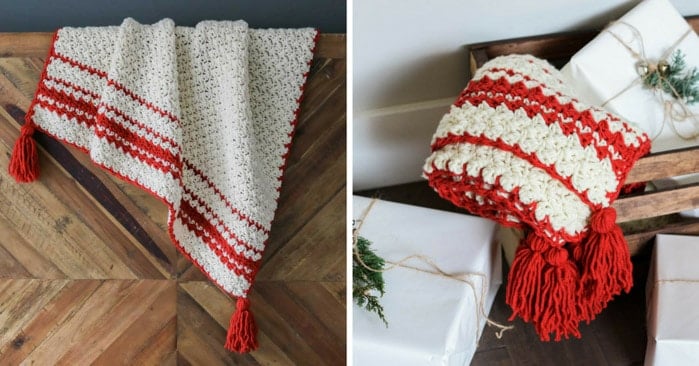
Festive Holiday Beginner Crochet Blanket
Chunky Afghans
Chunky crochet blankets are perfect for beginners or for those who want to finish an entire blanket project in a weekend.
Many people (including me!) love making blankets with bulky yarn because they can often be finished in a matter of hours. Plus, they often use simple stitches and easy row repeats.
See all our free chunky blanket projects →
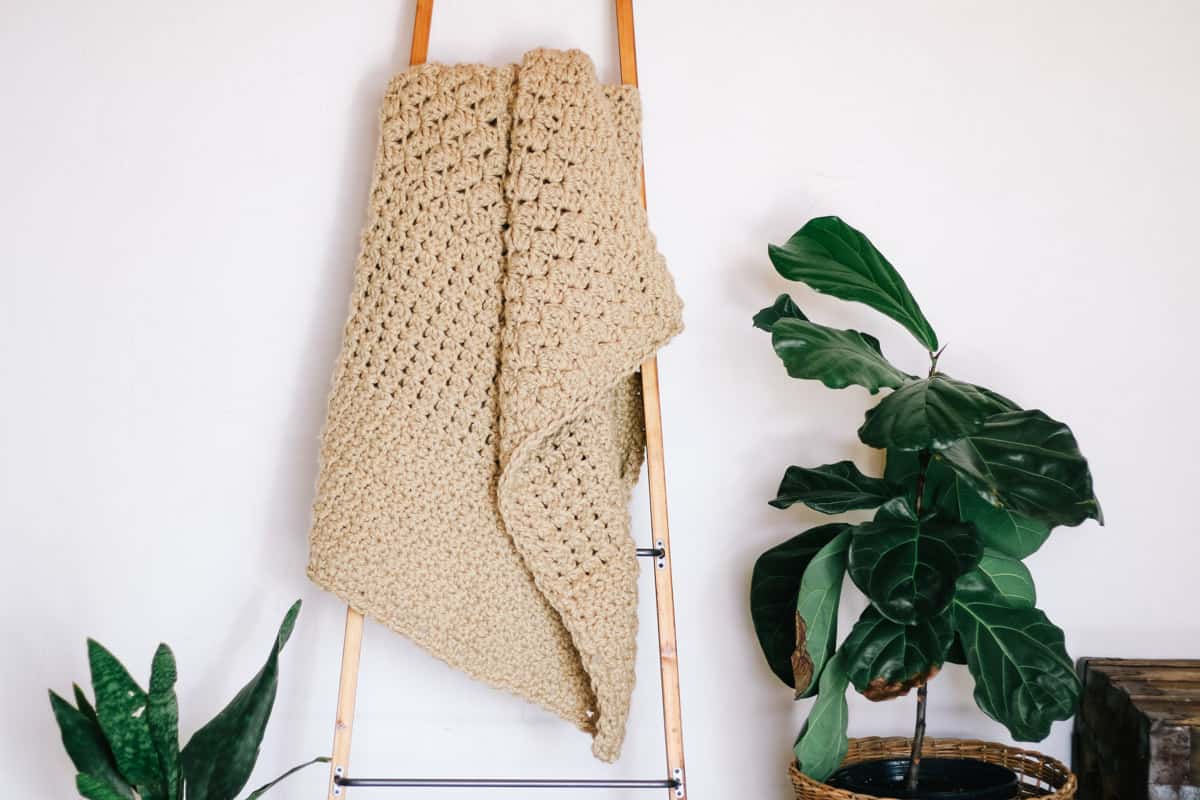
Beautiful Sampler Blanket

Free Bobble Stitch Afghan
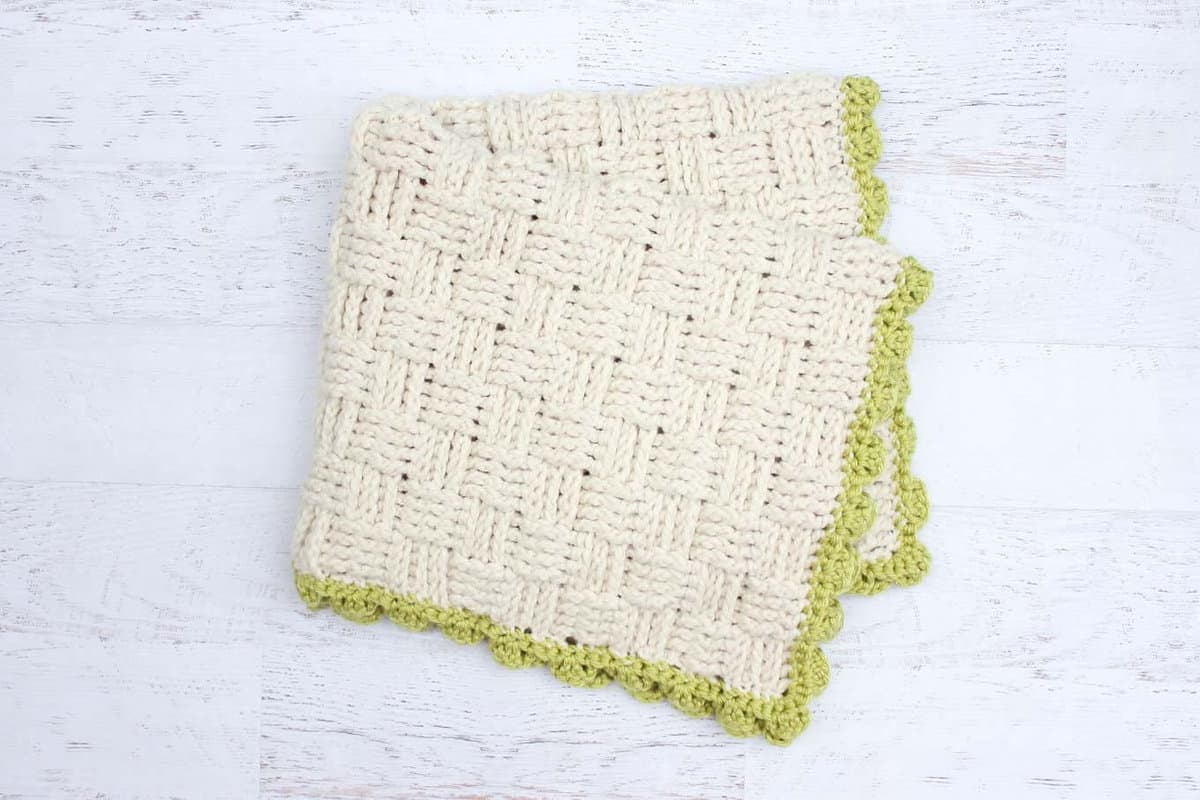
Minimalist Basketweave Blanket
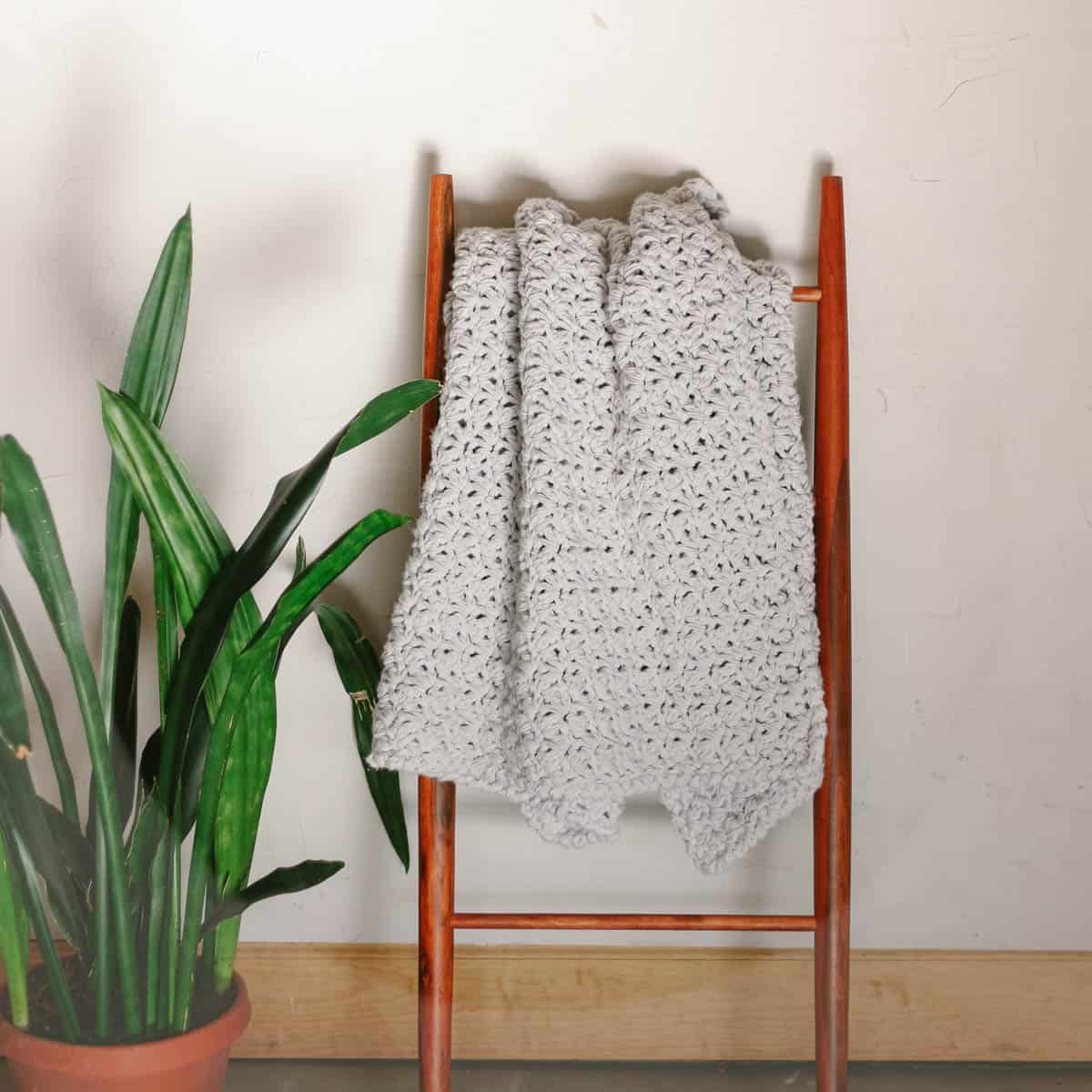
Chunky Blanket for Beginners
Throw Blanket Patterns
Crochet throw blankets and afghans are generally larger than lapgans and baby blankets. They can vary quite a bit in style, stitches, techniques used, and time investment.
Don't feel obligated to create a large afghan if it's your first time crocheting a blanket. If you fall in love with a pattern that includes information on the stitch multiple, you can easily make a lap blanket by reducing the number of foundation stitches and total row repeats.
Pro Tip: With large blankets, it’s especially important to read through the pattern ahead of time. This will help determine if it matches your skill level, yarn budget, and attention span. If so, go for it!
See all our free crochet throw blankets →

Easy Ripple Throw

Four Color Square Blanket with Tassels

Best In Show Dog Blanket
Fast Blankets + Afghans
We love fast crochet patterns around here. They can make perfect DIY gift ideas, and they're just really satisfying! The following quick crochet blanket patterns can be finished in a day or two (or less!) and use simple stitches.
See all our fast blanket designs →
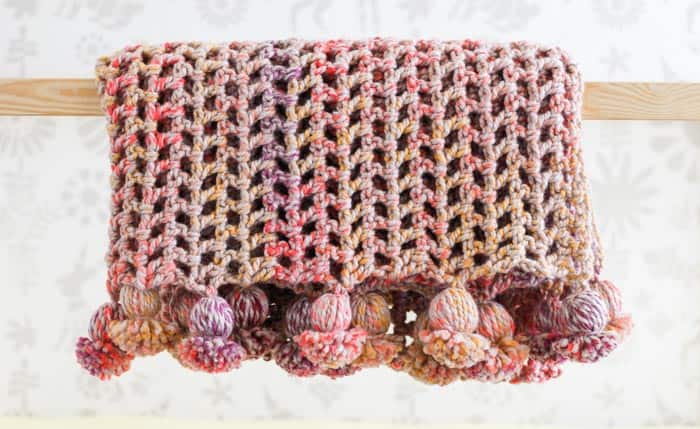
Presto! 4.5 Hour Fast Afghan

One Day Blanket
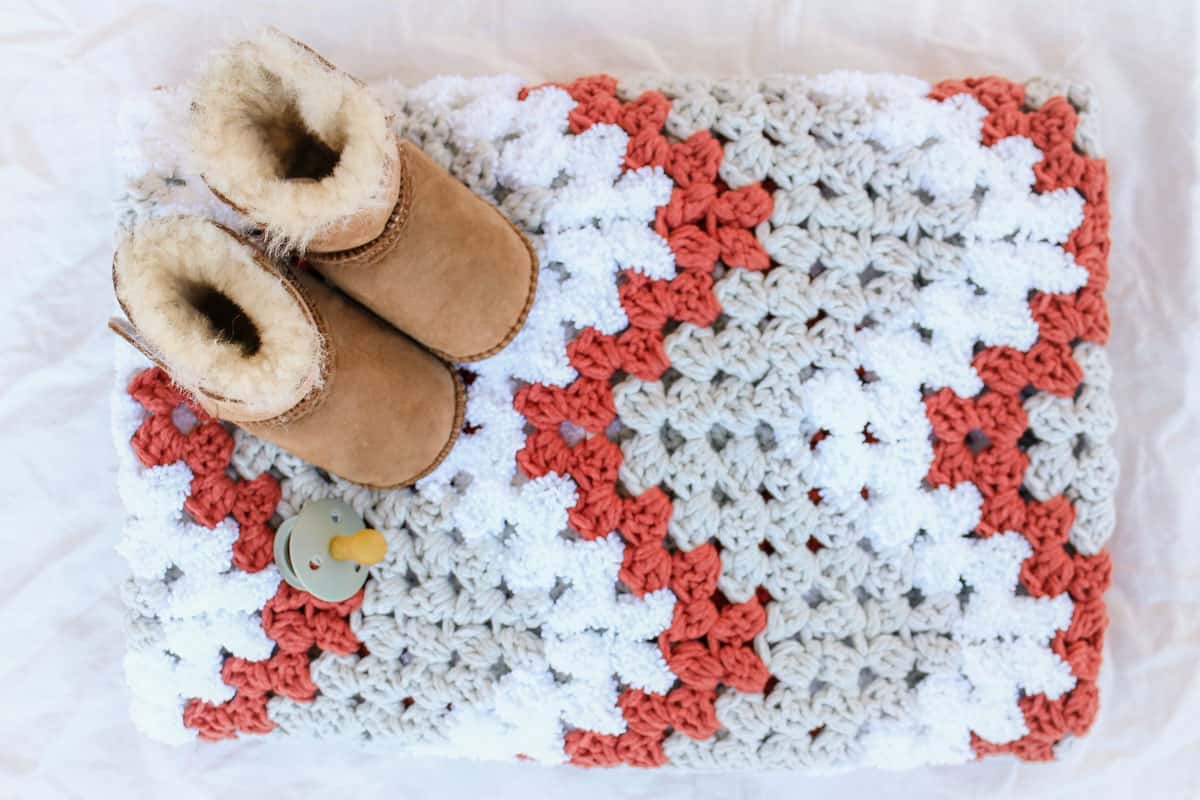
Fast + Easy Granny Ripple Stitch Blankie
Blankets Made of Granny Stripes + Granny Squares
There are very few crochet motifs quite as iconic as the almighty granny square. Many crafters love granny square blanket patterns because they can be built in small portable sections.
If you find yourself with a pile of grannies, be sure to learn how to join squares as you go to avoid extra seaming.
Pro Tip: I love granny stripe and granny square projects to use up leftover scrap yarn.
See all our free granny square blanket patterns →
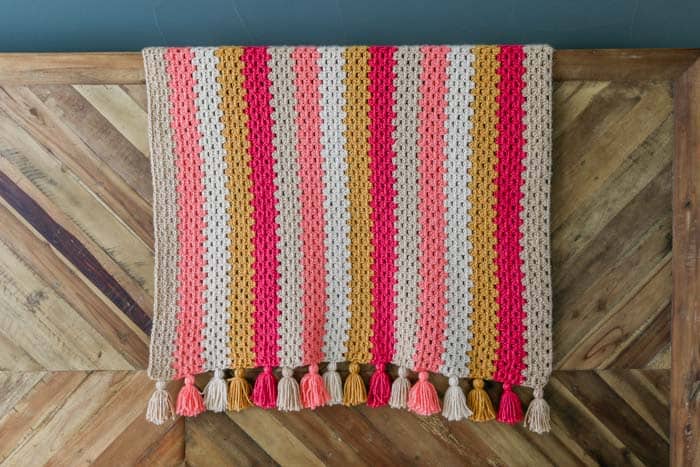
Playful Granny Stitch Blanket

Continuous Join Scrap Blanket
Free Crochet Baby Blanket Patterns
Learning about a new pregnancy is often what sends us searching for the perfect baby blanket to crochet.
Baby blanket patterns don't have to be reserved for newborns and baby showers though. These smaller blankets often work perfectly as adult lapgans and afghans for toddlers and older kids.
See all our free baby blanket projects →
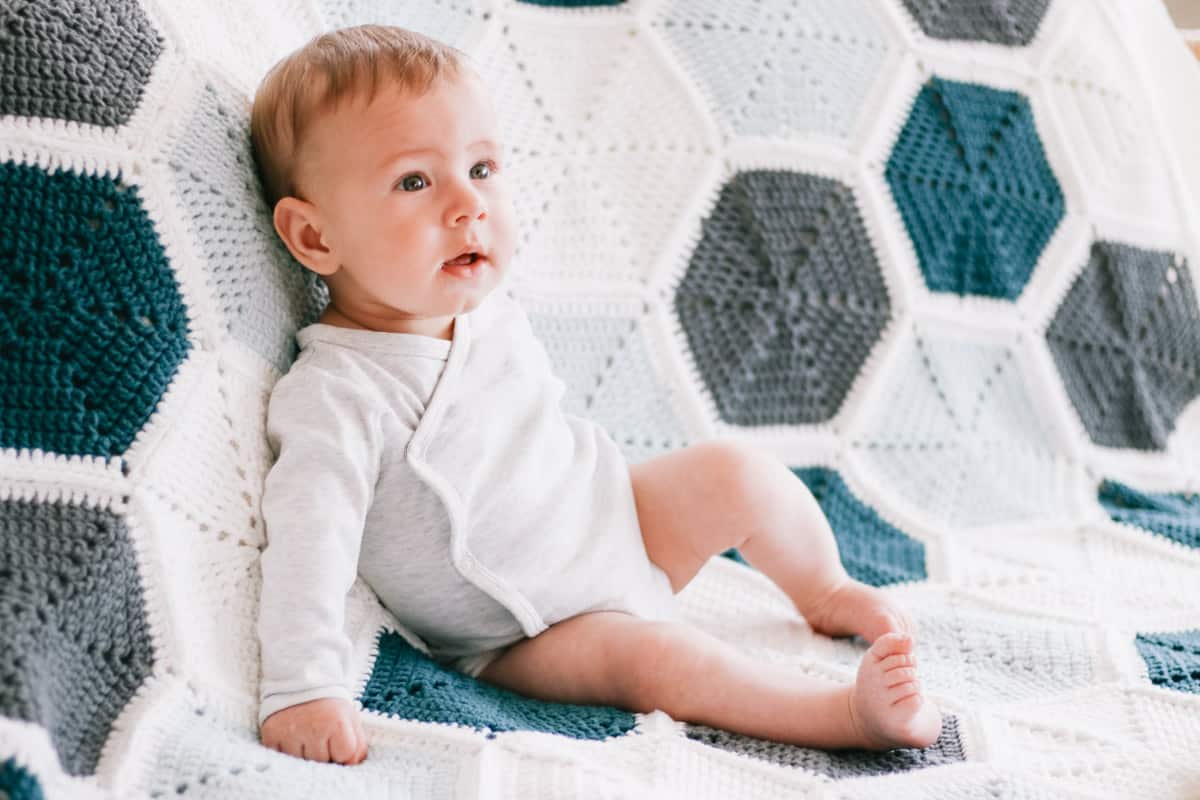
Join As You Go Hexagon Blanket
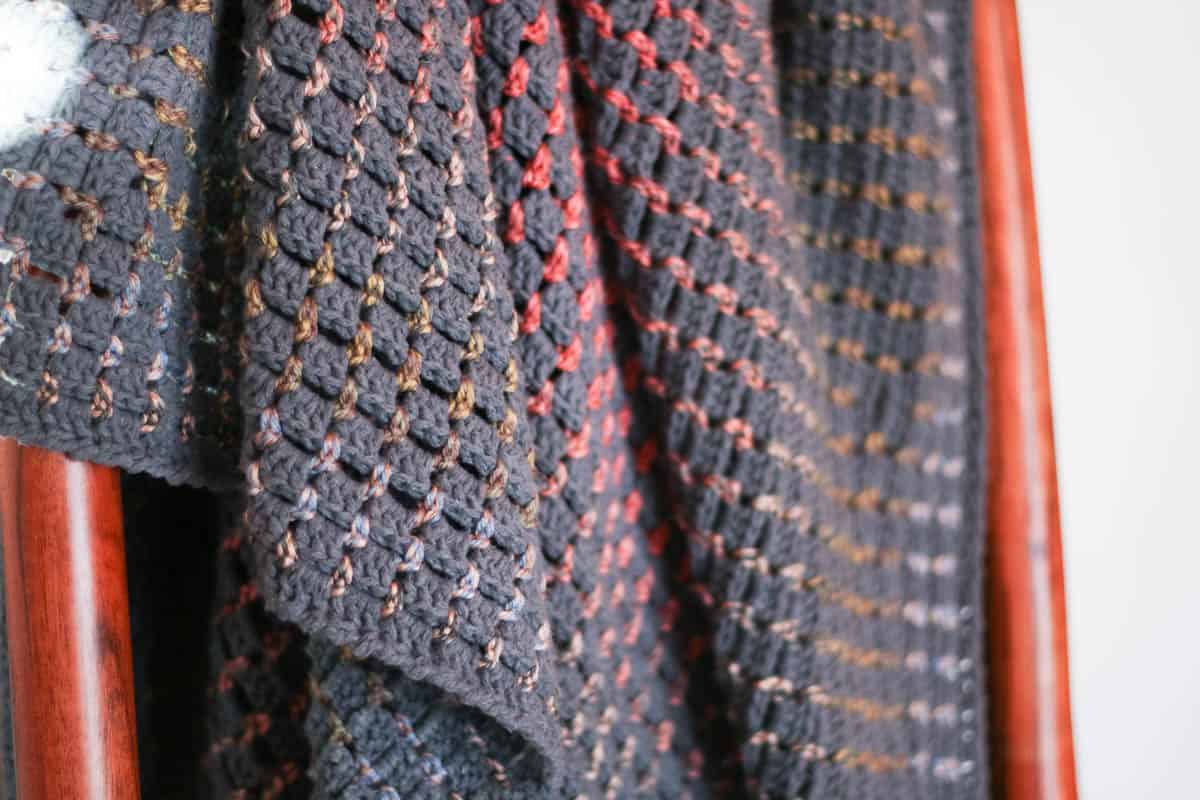
Boxed Block Stitch Blanket
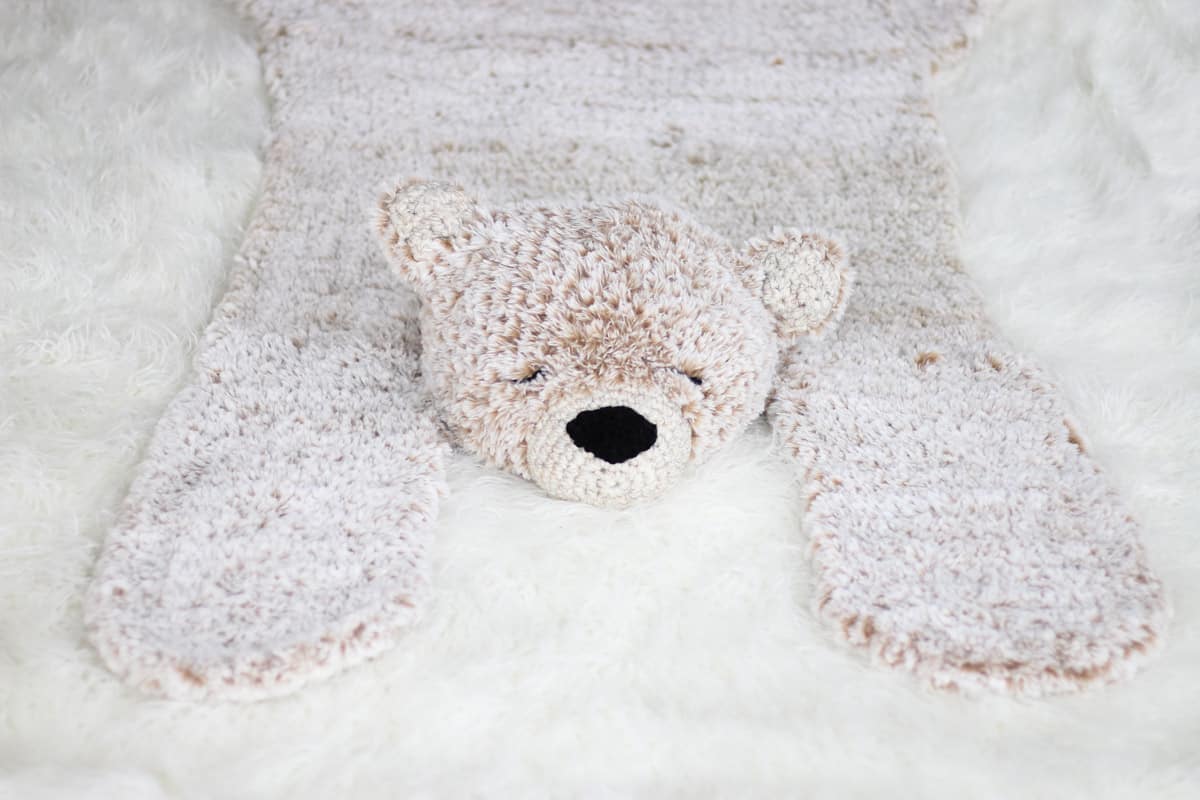
Furry Bear Blanket Rug

Unisex Zig Zag Baby Blanket

Loop Yarn Finger Knitting Blanket
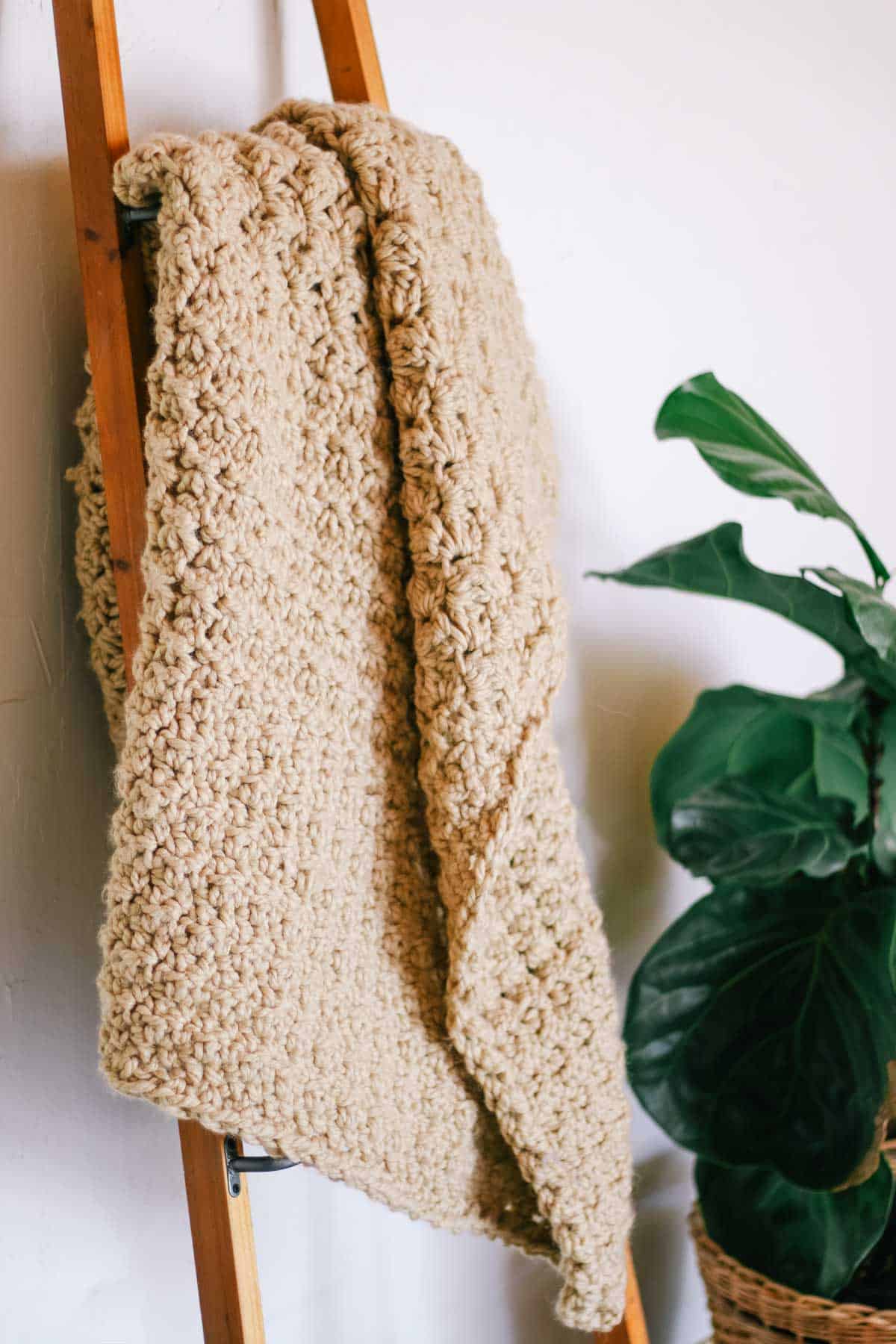
Recommended Supplies for Crocheting Blankets
Many of us choose blankets as our first beginner crochet pattern because they are quite easy to source supplies for. I still remember standing in Walmart picking out giant skeins of orange economy yarn as a ten-year-old planning the coolest crochet blanket EVER. Ha.
Soft Blanket Yarn
For most projects, choosing the right yarn is very important. Read the pattern to see which yarn is suggested. That is always a good place to start. Yarnsub.com can be really helpful in sourcing a suitable replacement if the yarn a pattern calls for isn't available to you.
While many types of yarn can be used to make a blanket, some work better than others. If you are designing your next afghan project yourself instead of following a pattern, here's a brief summary of why you might want to choose one yarn weight over another.
Worsted Weight Yarn (Category 4)
This yarn weight can be a nice balance between making fast progress on large projects while not sacrificing drape. And if you live a warmer climate, worsted weight yarn can make for a great blanket to keep in the living room that won't make you sweat if you decide to use it.
Chunky / Bulky Weight Yarn (Categories 5, 7, 8)
If you want to create a blanket in the afternoon or weekend, look for patterns that use chunky/super chunky yarn. Thicker yarn is also perfect for crocheting a cozy blanket with giant squishy stitches that are on-trend right now.
You will sacrifice a bit of drape when using a thick yarn, but often that doesn't make the biggest difference in afghans.
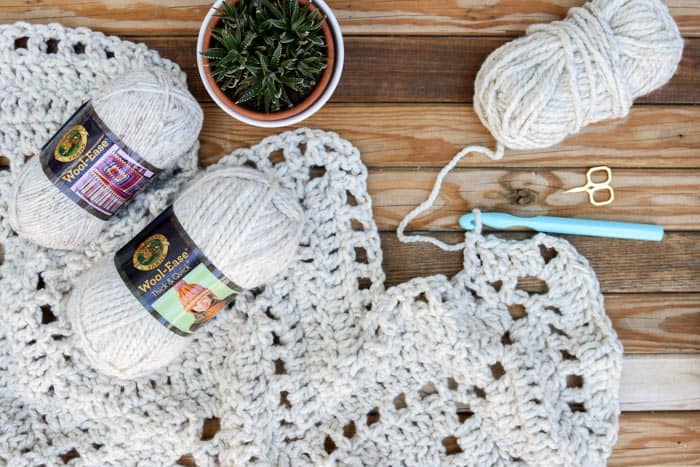
Crochet Hooks
A blanket is a relatively large project. This means you'll be holding the hook for long periods of time. Be sure to find a crochet hook that will be comfortable to hold.
Some of my favorite inexpensive yet very comfortable hooks can be found at Hobby Lobby.
Pro Tip: Be mindful of your posture and take stretching breaks if you're working on a blanket for long periods. Your shoulders and back will thank you!
Blocking Supplies
Crochet blocking is a process where steam is applied to crochet fabric to allow the stitches to become more even and uniform.
Blocking is generally optional for blankets. However, seaming together any smaller blanket pieces like granny squares or hexagons will be easier if they are first blocked.
You will need the following supplies to block your crochet pieces:
- Blocking board - or create a blocking board yourself out of a piece of foam
- Steamer - a spray bottle can also work
- T-pins
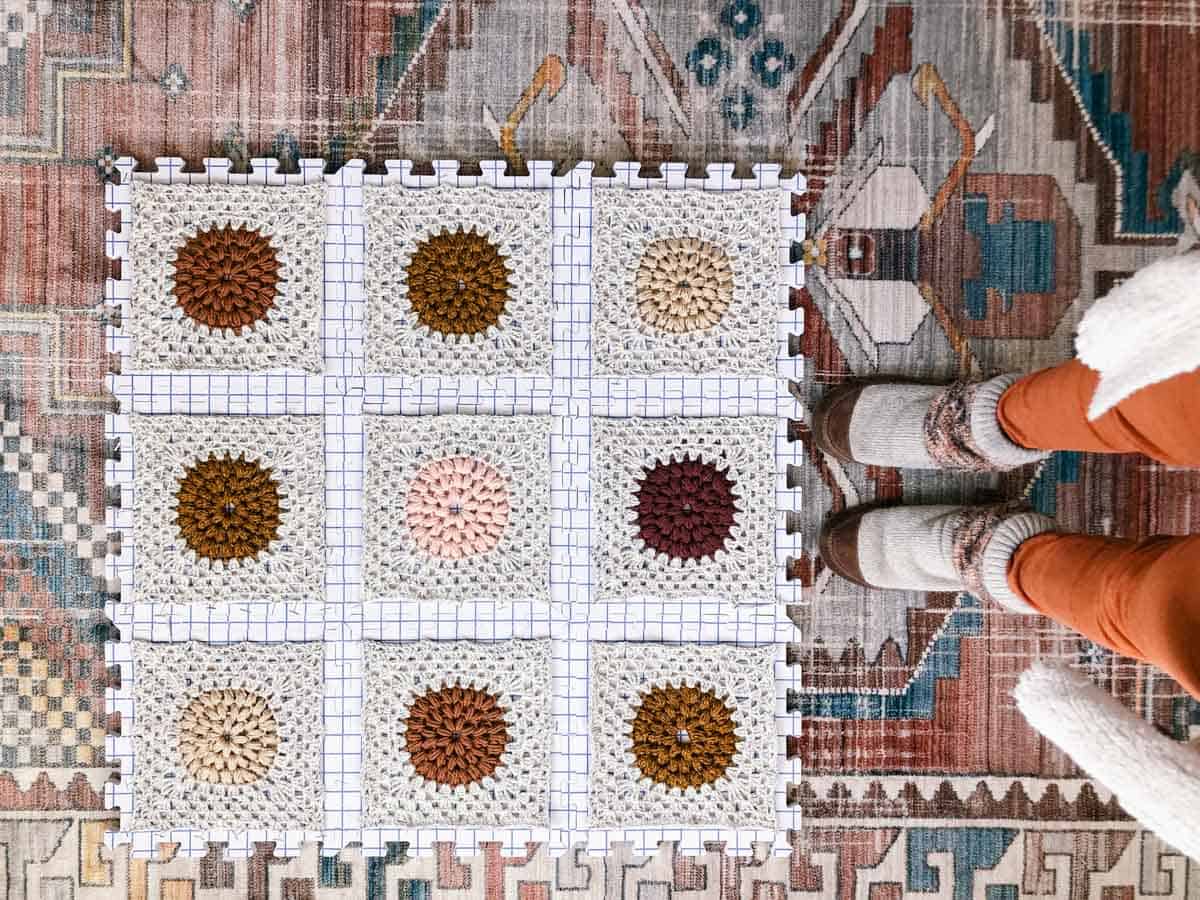
Choosing a Blanket Size
Many patterns will give you instructions on how to adjust the blanket or afghan size. Typically the blanket width is modified by changing the the number of stitches in your foundation chain. The blanket height is then modified by changing the number of rows crocheted.
Modifying Given Pattern Measurements
Therefore, to adapt the size of a crochet afghan, you will usually need to know something called the stitch multiple. This simply means how many stitches you need in the foundation chain for one repeat of the pattern, plus how many extra stitches you need to add to the foundation chain to accommodate the turning chain.
For Example: If a pattern said the stitch multiple was 10 + 3, you could use any multiple of 10 stitches (20, 50, 100) and then add 3 stitches the foundation chain (23, 53, 103 total chains).
Not every blanket pattern you come across will include notes on the stitch multiple, but it is definitely helpful when they do.
Wanna save this pattern?
Common Blanket + Afghan Sizes
Here is a guide to the most common crocheted blanket sizes. (Keep in mind these are general guidelines and many patterns will fall somewhere between these measurements.)
| Blanket Type | L x W (inches) | L x W (centimeters) |
|---|---|---|
| Baby Blanket | 38 x 38" | 97 x 97 cm |
| Lap Blanket | 36 x 48" | 92 x 122 cm |
| Throw/Afghan | 54 x 68" | 137 x 173 cm |
| Twin | 65 x 90" | 165 x 229 cm |
| Double | 85 x 90" | 216 x 229 cm |
| Queen | 90 x 90-100" | 229 x 229-254 cm |
| King | 108 x 90-100" | 274 x 229-254 cm |
How to Wash a Blanket
Washing a crochet blanket is safe if you follow some simple steps and pay attention to the care instructions on the yarn label.
These tiny tags have all the info you need to keep your blanket in tip-top shape. They let you know if it needs to be hand-washed or if it's safe to pop in the washing machine.
Pro Tip: If your blanket is large or delicate, you might want to let the pros handle it. To keep it spotless, drop it off at your local dry cleaner.
Caring for Different Types of Yarn Fibers
The kind of yarn used in a project will determine how to pamper it. Always follow the universal care symbols on the yarn label.

If you've misplaced your yarn label (it happens to the best of us), or it was a special gift, keep one golden rule in mind: hand wash it!
Take it from me, tossing your beautiful blanket into the washing machine without knowing the yarn type is like playing a risky game of laundry roulette. That’s one gamble you don’t want to take.
Washing Your Blanket In a Machine
Cotton and acrylic yarns are tough cookies that can handle a spin in the washing machine, but they still crave a bit of TLC. Follow these steps to keep them cozy and clean:
Step 1: Pop your throw into a mesh laundry bag to protect it from tangling or getting caught in the machine.
Step 2: Choose a mild detergent or a gentle baby shampoo.
Step 3: Set the machine to a gentle cycle using cold water.
How to Hand Wash Your Afghan
Got a wooly wonder or an unknown yarn blend? Hand washing is your best friend. It might take a little more time and elbow grease, but it's the safest bet. Here’s how to do it safely:
Step 1: Fill a bathtub, sink, or large container with cold water. Make sure there’s enough room to fully submerge your blanket.
Step 2: Add a small amount of mild detergent or shampoo to the water.
Step 3: Submerge your blanket in the soapy water and let it soak for about 10 minutes.
Step 4: Lightly massage the fabric with your hands - but don’t scrub or wring it. If your blanket is super dirty, leave it to soak for another 30-60 minutes.
Step 5: Drain the water and rinse the blanket with clean, cold water until it runs clear and there are no more suds in sight.
Drying Your Blanket
Ditch the tumble dryer and gently air dry your crochet items.
- First, carefully squeeze out any excess water.
- Next, lay the afghan on a dry towel and roll it up like a burrito, pressing firmly to absorb any water. This flat-drying method is the secret to preventing your project from stretching out of shape.
- Flip the item every few hours and replace the towels. This way, both sides can enjoy some fresh air and dry evenly.
- Once the blanket is completely dry, check the edges and reshape if needed.
Top Washing Tips to Avoid a Catastrophe
Want to keep your handmade blankets looking their best? Follow these tips to make sure you wash them right every time:
- Only use a washing machine without a central agitator. Those big blankets can get caught around the column, damaging the fabric.
- Whether washing in a machine or by hand, stick to cold water. Hot water can cause your yarn to shrink or pill, and nobody wants a lumpy blanket!
- When drying your blanket, don’t wring or tug it. If you do, you might end up with a misshapen mess. Plus, those carefully weaved-in ends could come undone.
- Don’t hang wet blankets by the corners. The weight of the water will stretch the fabric and cause a droopy disaster. Instead, try using a drying rack and moving the blanket around every so often to keep its shape.
- Be careful if drying your afghan outside. Too much sun and heat can turn your vibrant colors into a faded memory and might even cause the yarn to shrink or melt. Opt for a warm, dry place away from direct sunlight.
What is the Best Crochet Stitch for a Blanket?
Almost any stitch can be used, depending on how cozy or airy you want the afghan to feel. Pairing a chunky yarn with a single or double crochet stitch can be an ideal blanket project for beginners.
For intermediate crocheters, consider creating a blanket using Tunisian crochet. It creates a dense, cozy blanket and has a simple row repeat.
Basic Crochet Stitches
Here are a few basic stitches used in blankets and afghans:
Note: These are standard US terms.
Single Crochet (sc)
Single crochet stitches create a dense, cozy fabric. However, a single crochet blanket will take longer to create. This stitch is often used for classic ripple blanket patterns.
Half Double Crochet
Half double crochet stitches are slightly taller than a single crochet but not as tall as a double crochet stitch. This is a great stitch for creating a ribbed knit look.
Double Crochet
Double crochet (dc) stitches are taller and, therefore, faster than both half-double crochet and single crochet. This stitch can be a fantastic workhorse stitch that’s slightly more open than the shorter, denser options.
Any combination of these three basic stitches can create a beautiful beginner blanket.
Design a Blanket with Unique Stitches
Looking to create a design that's all your own? Consider these unique crochet stitches for your next blanket or afghan pattern. We've chosen these specifically because they work well for blankets. Each of these stitches includes a tutorial as well.

Beautiful Crochet Stitches For Blankets and Afghans
Best Tips for a Project You're Proud Of
You'll pick up many tips and techniques the more blankets you crochet. Here are a few of my favorite suggestions for crocheting an afghan you're proud of.
Block Your Pieces Before Joining
If you're creating a blanket that is built from smaller pieces, it is extremely helpful to block these individual motifs before joining them together.
One of the most important reasons to block your pieces is to ensure each motif is the same size. Whether you join the pieces with crocheting or with invisible seams, blocking them will make your final blanket "puzzle" fit together much better.
Finish Your Blanket with a Border
Many crochet afghans look good enough without a border. But I tend to find that adding a simple edging makes a big difference to how polished the finished blanket looks.
My absolute favorite simple blanket border is the crab stitch (AKA reverse single crochet). We often use this on our corner-to-corner blankets and any other patterns where we don't want the border design to detract from the main focus of the blanket.
What to Look for In a Pattern
A crocheted blanket or afghan is a large project that can take several hours or days to create. Before you begin, you'll want to read through the entire pattern.
Looking closely at these elements in a pattern will help you pick a project that is suitable for your skill. The following details are things to take note of when reading through an afghan pattern.
Skill Level
Choosing a pattern that matches your skill level will make the process of crocheting a blanket fun and enjoyable. An afghan made of basic crochet stitches and simple row repeats will be easier and faster to complete.
Look at the type of stitches used in the pattern and ask yourself:
- Is the stitch pattern common or does the pattern use complex or unique stitches?
- Can I easily memorize the pattern repeats (aka will you repeat the same 1-2 rows over and over or will you have to learn a new row instruction often)?
- Does the pattern require counting throughout?
- Is seaming needed to join pieces at the end?
Crocheting a blanket that uses more complicated techniques and repeats can be very satisfying. But it’s also good to know what you’re getting into before you begin so you can be sure it matches your skill level.
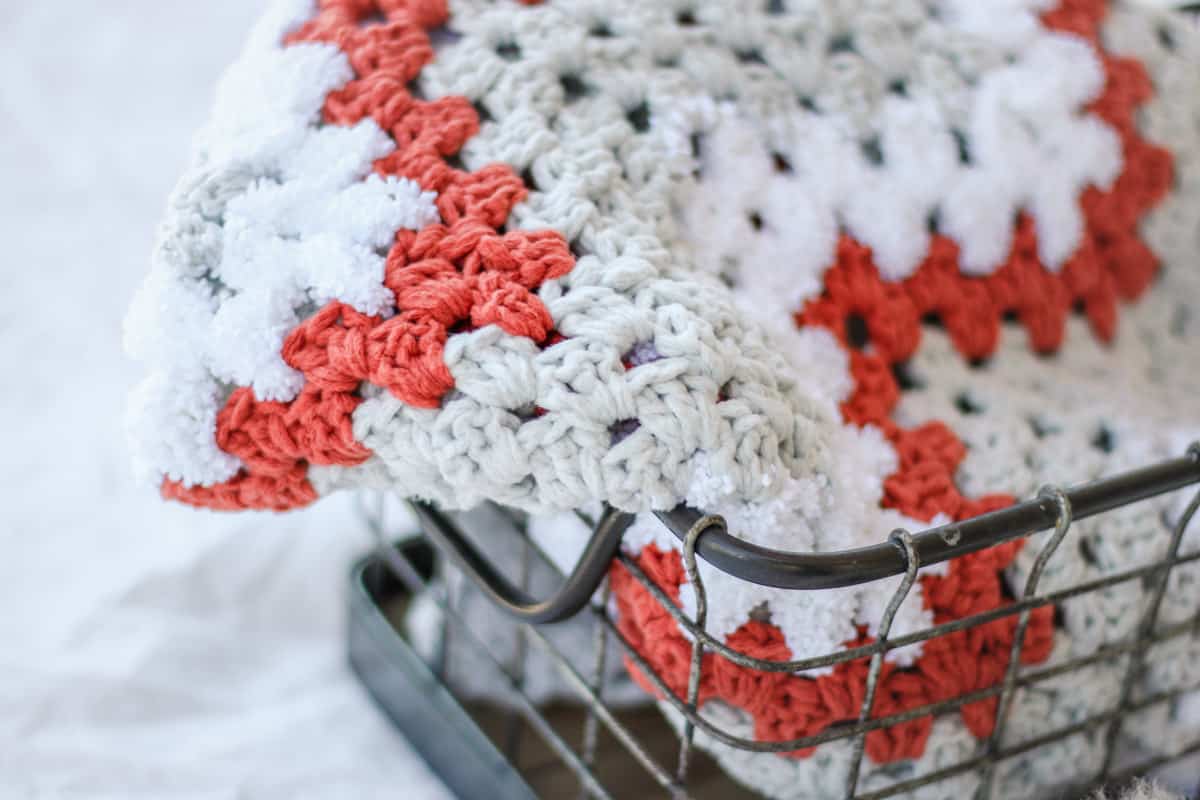
Color Changes
A colorful blanket is very beautiful once complete. However, there can be more work involved depending on how the colors are used.
Look at how colorwork is handled in the pattern. How many color changes are there? Do the color changes happen at the end of the row (easier) or mid-row (slightly harder)?
Perhaps the blanket uses a unique two-color crochet stitch, in which case you'll have more yarn to handle but likely not have to cut it at the end of each row.
Techniques like mosaic crochet and corner-to-corner graphgans create the most stunning blankets. However, they often include more yarn wrangling because of the number of different colors involved.
Try Self Striping Yarn
Prefer to avoid the extra work of changing colors, but still love the look of colorful blankets? (Me too!) Lion Brand Yarn Mandala patterns can be a perfect solution.
Related: How to plan your dream temperature blanket project
Yarn Tails to Weave In
Do you dislike weaving in many ends at the end of a project?
Fewer color changes and less intricate designs usually mean fewer ends to weave in. If you really want to minimize any finishing work, choose an easy blanket that can be worked in a single color.
Portable vs Seamless
The wonderful thing about a crochet blanket is that it can be created as a single large piece or in smaller pieces and joined at the end.
A blanket that is created in motifs (aka pieces) is more portable. You can work on a small section anywhere, at any time.
However, a pattern worked in pieces will likely need to be blocked and joined together with crochet or sewing.
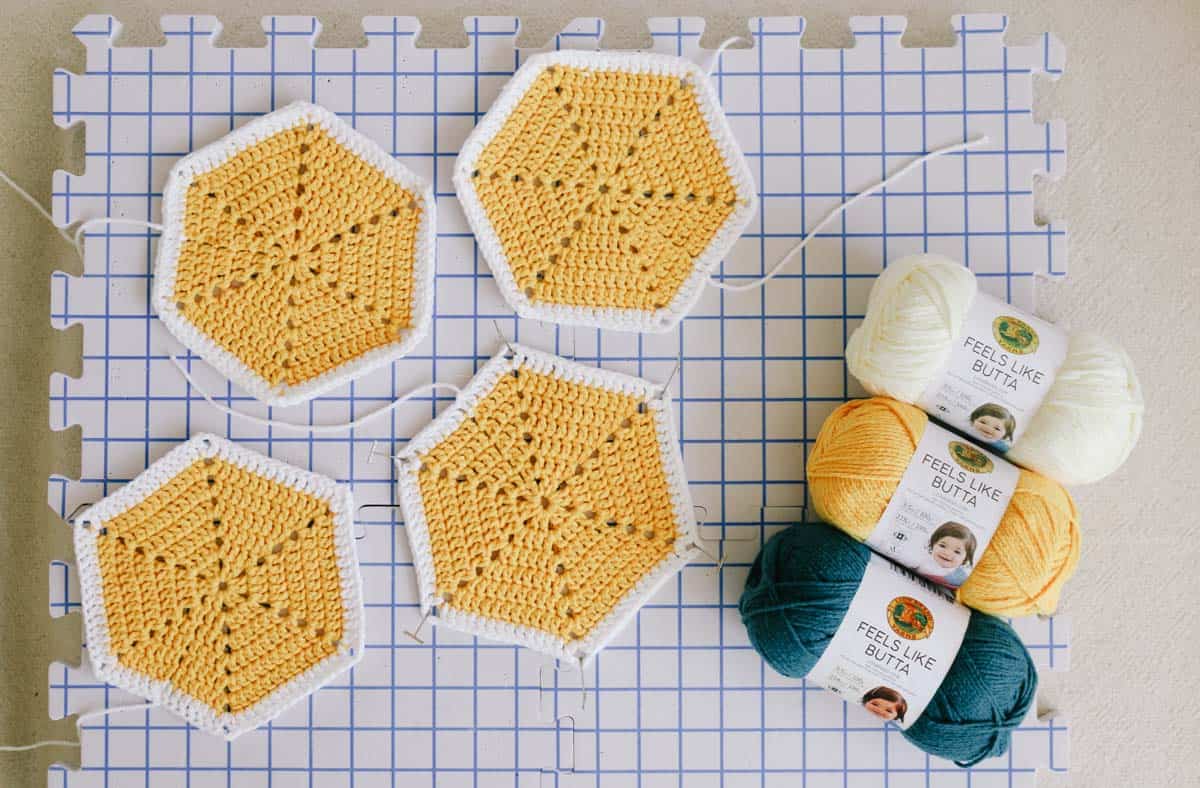
Crochet Blanket Video Tutorials
If you prefer to learn by video, these afghan patterns include helpful video instructions to get you on your way.
- The Hygge Holiday Throw uses the Suzette Stitch Video Tutorial
- The Dahlia Scrap Blanket includes step-by-step video tutorials
- Many of our crochet stitch tutorials are also perfect for simple blankets
What's the difference between blankets, throws, and afghans?
An afghan is a blanket or throw and is usually knitted or crocheted. So technically, there is no difference between aghans, blankets or throws. They are one in the same.
Afghans date back to at least the 15th century and can be made from a variety of fibre types. Afghans, blankets, and throws can come in a variety of designs, weights and sizes.
Wondering why a crocheted blanket is called an afghan? Learn more about the history and origins of afghans.
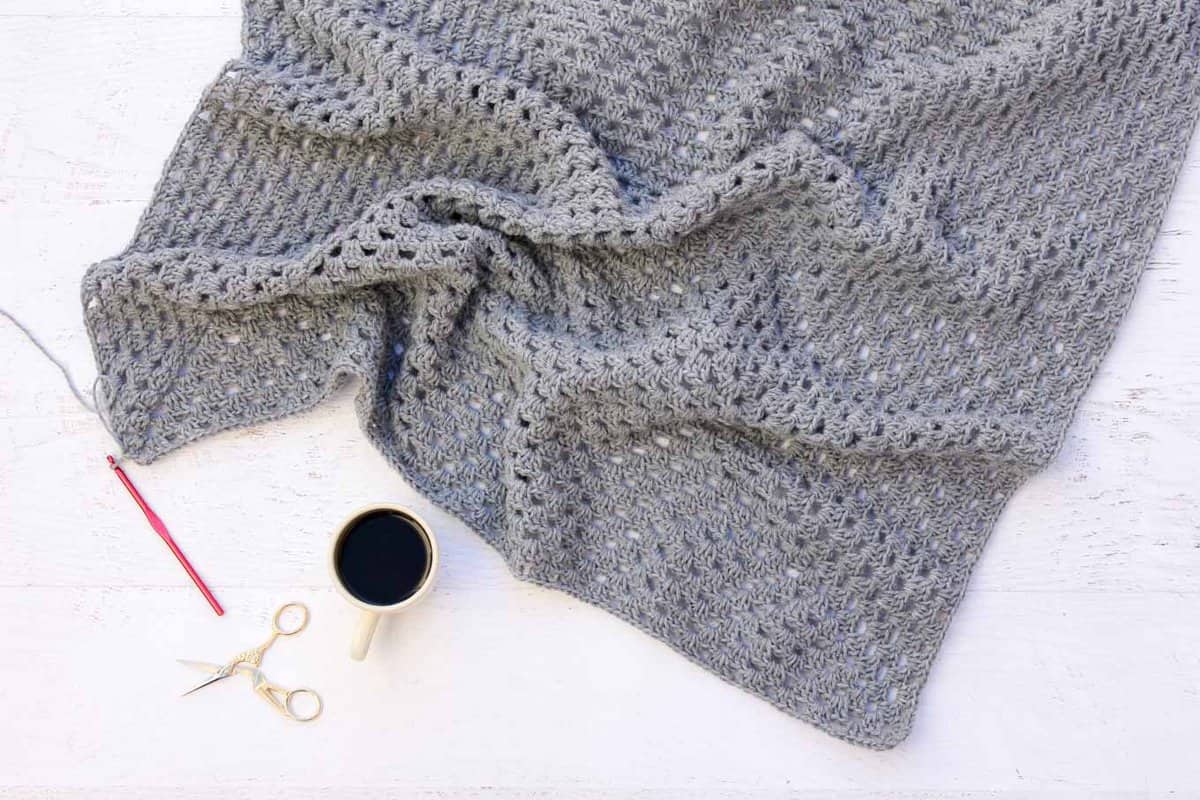
How long does it take to crochet a blanket?
A crochet blanket can be finished in a day or it can take dozens of hours to complete.
The time it takes to complete a blanket will depend on the blanket size and yarn thickness. Reading through the crochet pattern to understand what is involved and the type of yarn needed will help you to determine the time it will take to create a blanket.
TIP: To find out how long it will take to finish a blanket, do this:
1. Time yourself crocheting one row
2. Multiply that time by the number of rows in the pattern
3. This will give you the estimated time it will take to complete the blanket
Is it faster to knit or crochet a blanket?
In general, it's faster to crochet a blanket than knit a blanket. Crocheting uses only one hook and one main hand, so it’s very fast and easy to create any size of fabric. Most crochet stitches are larger than most knitting stitches, meaning the afghan can grow faster. Crocheting also creates a thicker, textured fabric, which makes it ideal for blankets.
How many skeins of yarn do you need for a blanket?
The amount of yarn it takes to crochet a blanket depends on the pattern and type of yarn. Any blanket pattern should suggest a type of yarn and explain how much you’ll need.
If you plan to modify a pattern's size, yarn type, and/or hook size, be sure to create a gauge swatch. This will help you to calculate the amount of yarn needed to crochet a blanket.
What size crochet hook do I need to make a blanket?
Check the pattern and yarn for the hook size needed to crochet a blanket. A large hook with super chunky yarn will make for a faster blanket than a small hook with lighter-weight yarn.
How to start a crochet blanket?
A blanket begins with a series of chain (ch) stitches. The chain can be very long if you plan to crochet a large blanket. Place a stitch marker every 10 stitches to help you keep count.
How much does it cost to crochet a blanket?
The price of yarn will vary greatly depending on the type of fiber, dye, and quantity needed. There are many affordable yarns to use for crochet blankets. Consider blanket yarns such as:
• Lion Brand Pound of Love - a light worsted weight yarn with tons of yardage. It's awesome for holding multiple strands together to create an economical, chunky yarn.
• Lion Brand Mandala - beautiful, DK weight yarn that does the color changing for you, meaning there are fewer ends to weave in.
• Lion Brand I Wanna Make a Blankie - enough blanket yarn to crochet an entire blanket.
Can you crochet a blanket in one day?
Yes! Look for a pattern that uses simple stitches, easy row repeats, and super chunky yarn for a blanket that can be created in a day! Here are our fastest blanket crochet patterns.

What is the average size of a crochet blanket?
Crochet blankets can be made in almost any size imaginable. That said, 54" x 68" (137cm x 173cm) is a good size range to aim for with a crocheted afghan, blanket or throw.
That was so fun! Now what?
Invitation to our Facebook group
Come discuss crochet blankets and lots of other projects and techniques in our Make & Do Crew Facebook group. Here, thousands of helpful crocheters answer each other's questions and share their stitches.

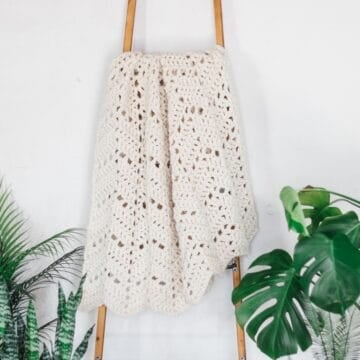
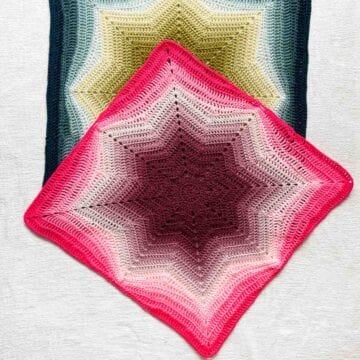
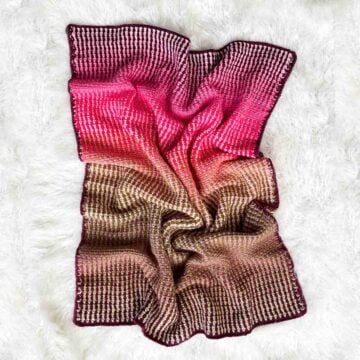
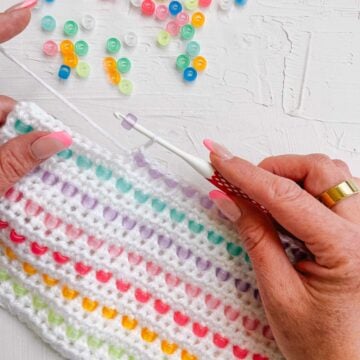
Leave a Reply